#quality changes because I drew them at different times for example it was like 2:30 am when I drew lamb and poppy
Explore tagged Tumblr posts
Text
So a while ago I drew/skeched out Lamb’s Spouses
Decided to share them here because why not
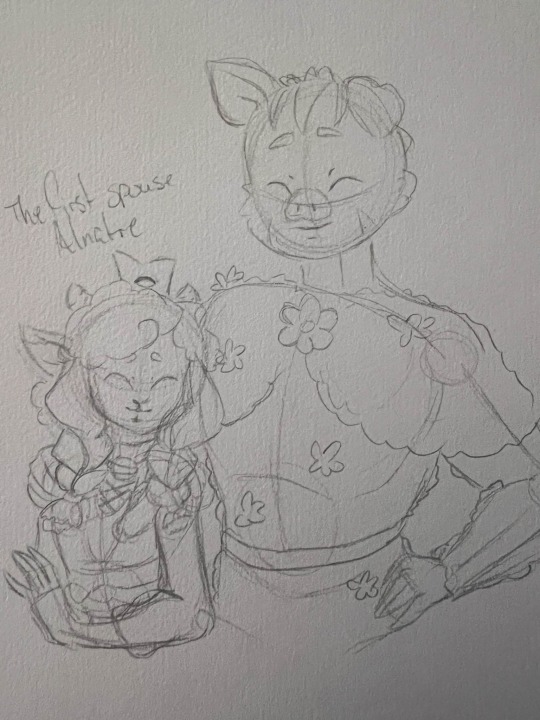

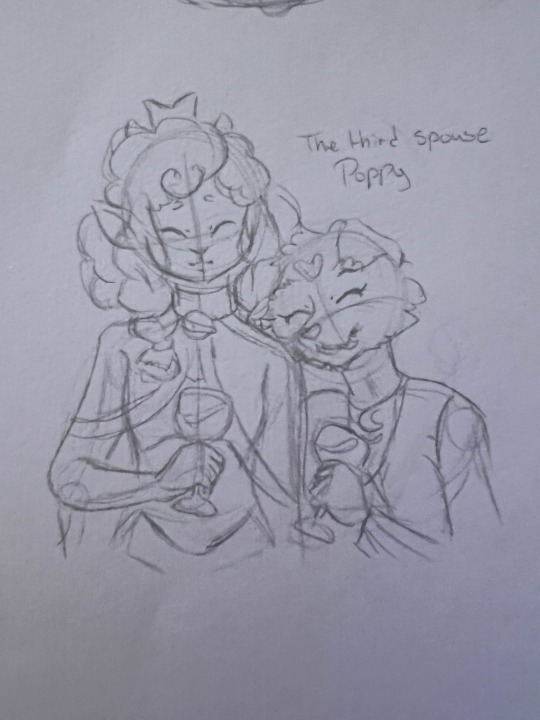
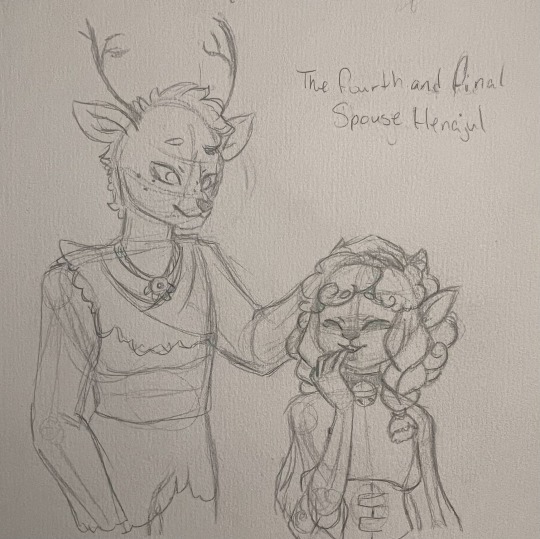
Also drew the kids if anyone is interested in seeing them

#artists on tumblr#cult of the lamb#cotl lamb#lamb’s babies#quality changes because I drew them at different times for example it was like 2:30 am when I drew lamb and poppy#working on refs for them#cotl rosa amor#cotl oc#fun fact: the kids actually mirror the bishops and what they were like before e everything went to shit#it was unintentional but when I realized it then I decided to fully go for it.
4 notes
·
View notes
Text
TAFAKKUR: Part 355
DIARY OF A HONEYBEE: Part 2
The honey I make is composed of water, sucrose and glucose and is very rich in vitamins. It contains enzymes to digest carbo-hydrates. It is very delicious and healthful. Some part of the honey I make may come to your table one day. I will have died by the time you are eating it. You have no obligation at all to remember me, but do not forget the One Who provides you with it through me and thank Him.
Day 32 - Thousands of bees die in our comb every day and other thousands are born. This happens in so orderly a way that no confusion is seen.
There is one among us without whom it is impossible for things to be in order in our comb-the queen. She is a bit larger than us and was programmed to do things different from what we do. She cannot collect nectar nor make honey, nor feed the larvae. She cannot feed herself either. We, her daughters, feed her with the royal jelly we offer to the young larvae.
The queen bee lays eggs. She must lay around 2000 eggs every day, for our lifespan is very short. While we are feeding her, she lets us taste from a substance she produces. We go round the comb and so cause all female bees to taste that substance by which a kind of birthcontrol is secured in the comb. On the day we do not taste it, we all begin to lay eggs. Since those eggs are not fertilized, only male bees come from them. Male bees have no task other than inseminating the queen bee. Their number is quite limited. If they were to be too many, the order in our comb would collapse.
Day 35 - A new factory has started to work in my body today. This factory installed in the back, lower part of my abdomen produces wax. I collect that wax with the sticks on my middle legs and chew it to mould it into the cells of the comb.
The cells we make are hexagonal in shape, because, compared with the amount of the wax used to build them, as much honey as possible can be stored in them. Also, a hexagonal form is most resistant to external forces. We make 35 thousand cells from half a kilo of wax and store 10 kilos of honey in them. We need three and a half kilos of honey to make half a kilo of wax.
We make cells in different forms according to need. While making them, we take gravitation into account. For example, the cells where the female worker bees lie horizontally form a vertical layer, while the cells where future queen bees lie vertically are parallel to the earth surface. The cells where male bees grow are bigger than those of the females. As you certainly understand, it is impossible for us and for any other things in nature, including what some of you call natural forces, to know and arrange all these things. There must be One Who does it. One Who knows us together with our relation with our environment and employs us in many important tasks.
Day 37 - (your June 11)- So far, I have left my comb on many occasions but only to throw out the waste matter and had opportunities to see the outer world from afar. Today I left my comb but not to discard waste but to fly around the comb, to obtain knowledge of the outer world.
Flying is very tiring for us. Unlike birds, we do not flap wings. When we start to fly, our wings move automatically in a way to make 250 complete turns in a second. While flying, our front and back wings are bound to each other.
When we start to fly, our wings curve along certain lines in a way to adjust our body to the air current. They draw a figure-of-8 shape in the air. In proportion to the size of our wings, our bodies are heavy (unlike birds which fly). They grow heavier when we collect nectar from flowers. Despite this, we can fly 15 kilometres an hour.
Like our flying, our landing is also miraculous. Unlike birds and your planes, we do not need to decrease our speed before we land. Thanks to the tips of our legs, while flying in the air, we can immediate- my alight wherever we want.
Since our wings move at extremely high speed, our need for fuel is high. Our muscles have a metabolic rate ten times faster than the heart of a man. We consume sugar as fuel. Before we start a journey, we take enough ‘fuel’. However, if the amount of sugar in our blood reduces to 1 per cent, we obtain new food wherever we are.
Day 38 - My new task is keeping guard at the entrance of the comb. No one, not even other bees, are allowed to tenter our comb. We know one another by our smell. The smell of each community of honeybees is different. Our antennae distinguish between the smells very well. The entrance of our comb is also marked with the smell particular to our community. Any other creature which does not carry our semll is prevented from entering.
Day 39 - There have been some changes in the comb. The cells of about a dozen larvae have been made bigger and turned vertical. The larvae in them will be fed with royal jelly until they become pupae.
The queen bee has accelerated laying eggs. She lays about 2000 eggs a day.
Day 41 - Now I am a fully mature honeybee. I will no longer do the housework because the factories in my body producing royal jelly and wax have stopped. From now, I will spend my days collecting nectar from flowers.
Today it was my first flight outside. When I flew far away from the comb, I found myself surrounded by a design of colours. The scents coming from all around nearly caused me to faint. Flowers attract us by their colours and smells. They have structures arranged as if to serve as platforms for our landing. When we land on them, we pass our tongues into the source of nectar in their centres. Meanwhile pollen from the flowers clings to the hairs on our bodies giving them the look of prickly sticks. We leave some of this pollen on other flowers we visit and thereby assist i the pollination of flowers. But for this service we perform, you would not enjoy the benefit from fruit-bearing trees such as peach, apple, pear, almond and plum.
We do not visit flowers at random. Whatever kind of flowers we visit first, we continue to visit the same kind in the same environment. If we did otherwise we would be carrying pollen of other kinds of flowers and therefore waste the pollen, uselessly.
We are mostly attracted by blue. However, we also visit flowers of other colours except red. Red flowers do business with butterflies.
We do not see flowers in the same colour as you see them. Only the nectar containing central parts of the flowers you see as yellow appear to us as yellow to attract us to you see as white appear to us as coloured. In short, when we go on a journey to collect nectar, we do not look for them. Flowers themselves smile to us and attract us.
Day 42 - I have spent today also among flowers. If you had followed, you would have seen that I visited around twenty flowers in a minute and as many as 20,000 by evening. I stored the nectar in my stomach and the pollen in the sacs on my back legs.
Since our return is difficult because of our load, we follow a direct way called the line of bees. Even if we pass through places unknown to us, we always follow that direct way. It is extremely easy for us to establish it. The place and position of the sun gives us our direction, Of course, the sun has changed position while we are visiting flowers. That is no matter at all. You cannot compete with us when it comes to calculating the exact place and position of the sun at any time of the day. If you kept me in a dark place and then released me hours later, it would not take me more than a few moments to find my direction. We use the atmospheric polarization and find the place of the sun by means of any little light coming from any corner of the sky. We have been doing this calculation for millions of years but you have come to know it only in the last forty years.
We cannot make our way only on completely dark days and therefore we do not go out on those days. We stay in and are busy with the work in the comb.
Day 44 - We are a big anonymous company with its tens of thousands of partners and personnel, agents, boards of directors, awesone storage and processing establishments and a well-developed communications network. We pursue big markets to do business.
We do big business. Many other insects, flies and butterflies visit the flowers with which we do business. However, when we find a profitable source, we rush toward it as an army of 10 or 20 or 30 thousand bees.
Five per cent of our population are responsible for finding a market. They constantly search big markets and we evaluate the markets they have found. If, for example, one of our friends finds a market of one million flowers in the morning, you will see their nectar and pollen transferred into our depots in a few hours.
Our communication system works perfectly. Let me describe this to you with an example.
It was nearly noon. One of the elder bees entered the hive in great excitement. Other grown-up bees crowded around it.
From the smell of the pollen on its body we could understand what kind of a source it had found. We tasted the nectar it threw up onto the comb from its mouth. It was a bit more watery than it should be. However, we had to take into account the heat outside and the fact that that sample had been collected in early morning. The amount of sugar in nectar in morning hours is less than at other times. In short, the kind and quality of the nectar seemed OK. But we did not yet know the location of the source and whether it was a rich site, nor how far away it was.
Our friend immediately began to dance. A few bees near it and I held on to it to follow its movements. While dancing, it uttered some sounds which meant that the source was rich, and drew a figure 8 over the comb, completing a turn in 15 seconds, which meant that the source was 10 kilometres away. Our friend was dancing according to gravitation. While drawing the line in the middle of 8, it made an angle of 28 to the right. Since we always take the sun to be at an angle of 90, the source our friend described was 62 to the right of the sun.
The information our friend gave to us was for a still, windless day. However, it was windy when we left the hive and therefore, taking into account the direction and strength of the wind, we corrected the angle given to us.
Day 47 - Our population has recently increased. We are about 60.000 bees. Our hive is not enough to accommodate all of us. Preparations made over the preceding few weeks mean that some of us will move to another place.
#allah#god#prophet#Muhammad#quran#ayah#sunnah#hadith#islam#muslim#muslimah#hijab#help#revert#convert#dua#salah#pray#prayer#reminder#religion#welcome to islam#how to convert to islam#new convert#new muslim#new revert#revert help#convert help#islam help#muslim help
1 note
·
View note
Note
The fanon wiki lists Tsukishima's first appearance to be chapter 13, with Capt. Wada. The anime also shows this as well. The man resembles Tsukishima, but is it really him? In the manga version I'm reading (I'm reading it online so the volume versions might be different), he just looks like a generic soldier. The first truly recognizable Tsukishima can be found in chapter 70, so shouldn't that be his first appearance? (I'm sorry it's hard to understand, I have no idea what I'm talking about.)
It’s a good question.
So let’s clear up some things. The online version uses the volume scans for the first 10 volumes, in short up to chap 100.
They then moved to a scanned version of the magazine version up till chap 152.
From chap 153 onward (if I’m not wrong) they used the digital version of the magazine version.
So scanlations come from the magazine version from chap 101, but quality increases from chap 153 due to them using the digital version of it.
So basically yes, for chap 13 you were reading the volume version.
Now... when do Tsukishima truly appear for the first time?
In chap 70 which is the first time in which we hear someone (Tsurumi in our case) say the name ‘Tsukishima’?
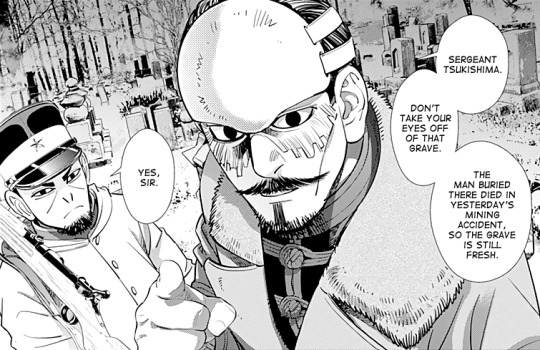
We know for a fact Tsukishima was around earlier than that.
A Japanese fan managed to ask if soldiers that were looking like Tsukishima were his relatives and Noda replied they’re all Tsukishima... even though his name was never mentioned back then.
Question number 5 (30 March 2018)
Q: I’m curious to see a soldier that looks like Sergeant Tsukishima in book 4 chapter 31
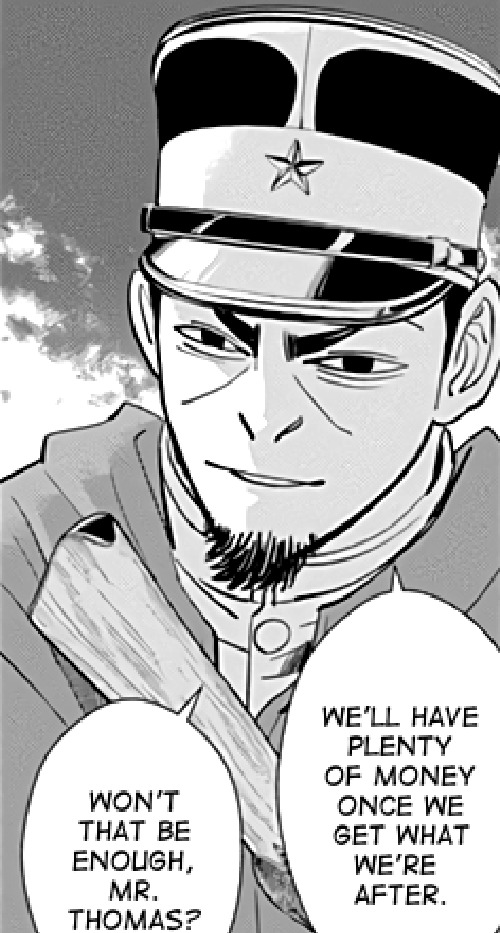
& book 5 chapter 46.

Is he a brother of the sergeant?
A: They’re all Tsukishima. [Translation from Golden Kamuy Central]
Sadly he didn’t ask about the guy in chap 13 but the fact that those guys are all Tsukishima though, confirms that Tsukishima was around prior to chap 70 but the character design for Tsukishima wasn’t established right from the start.
The beard changes shape, the clothes vary.
This lead fans to assume that since Tsukishima was around PRIOR to his official apparition, Tsukishima was meant to be the identity of the following soldiers:
- The guy murdering Wada in chap 13 (same eyes, beard, similar nose although a bit more marked than Tsukishima)

- The soldier with Tsurumi in chap 34 (same face but missing beard)
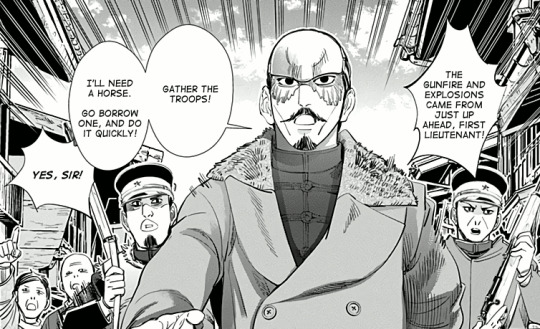
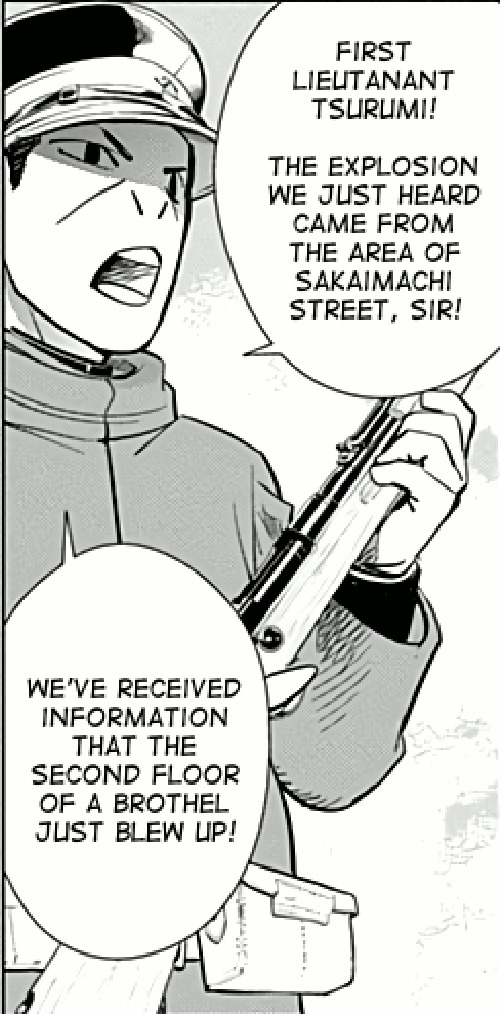
- and this guy who also appear in chap 46 (same face and same clothes Tsukishima wears in chap 46 but beard missing)
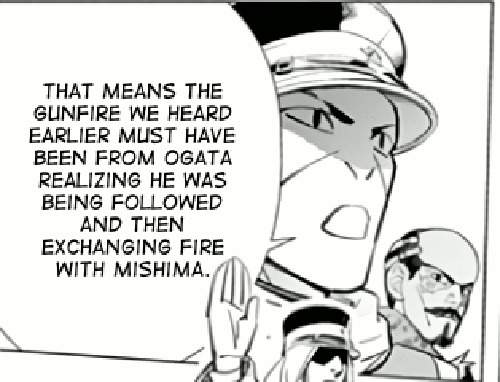
It’s also worth to say that as Noda draws characters in very different ways the fact that those characters are instead VERY SIMILAR seems to support the idea they were meant to be all the same character.
The anime seems to side with fans as it confirmed all the above speculations using Tsukishima instead than a random stock soldier.
Ep 3 (chap 13 scene)

Ep 8 chap 34 scene
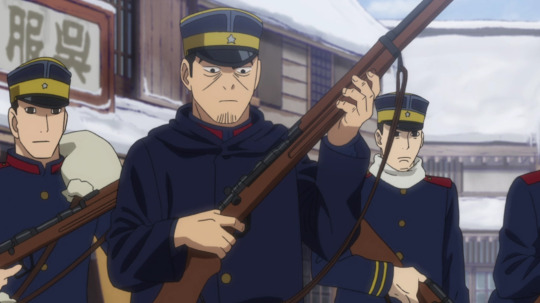
Ep 10 chap 46 scene
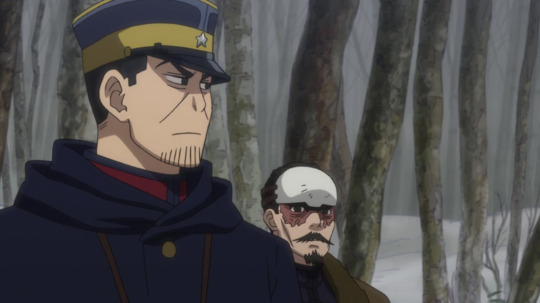
Tsukishima’s voice seems the one to be used in Ep 2 to tell Tsurumi Ogata has regained consciousness (chap 7 in the manga) but, same as in the manga, we don’t see the speaker.
If the anime confirmed the fan speculation in accordance with Noda or on his own it’s up to speculation as we’ve no idea. What we know is that they had stock soldiers they could have used instead of Tsukishima who, in the first series, didn’t really need to be used as the anime had no idea there would be a second series for quite a while as this is tied with the success of the first series.
Anyway, how common it is for a character design not to be established right from the start?
Common enough although the changes can be small or relevant...

...though I dug into this more in another ask, in which I also analyzed Tsukishima’s character design changes.
Character design changes are sometimes fixed soon, Tsurumi’s design was immediately corrected for the volume version so that in the following chapters he appeared with the right design, Henmi and Usami’s design were fixed the chapter after the one he appeared, but sometimes not to sooon.
Ogata’s character design was changed at his second apparition but there was no way to fix it on the volume version and Noda didn’t even try to do it with the flashbacks showing Ogata in vol 1, Vasily’s character design was fixed only when the chapters were transposed in the volume version in short months after he appeared on the magazine.
It changes from case to case.
But yes, you might argue, who says we should accept, as the anime did, that the guy who drew Wada out and shoot him is Tsukishima? Can’t he be a stock character?
As long as Noda doesn’t confirm it, everything it’s possible and, even if he confirms it, actually everything remains possible, after all Noda even retconned the time in whcih Wilk was jailed and wrote out of the story one of the fake skins so let’s keep in mind this is his story, retcons are an uncomfortable but valid way to fix things in a story and he’s human and can forget details.
Honestly, unless Noda has a better plot in mind for him, I believe it would be detrimental to Tsukishima if that guy were to be a stock character.
Tsukishima is basically Tsurumi’s right-hand man and, since Kikuta is in Noboribetsu and Koito in Abashiri, the higher in rank. It makes sense to send him to Captain Wada, to draw him there, and it makes sense Tsukishima, the higher in rank after Tsurumi, would do that work so as to set an example for the other soldiers.
We know Tsurumi made clear to Tsukishima he would have to do dirty things and Tsukishima agreed.
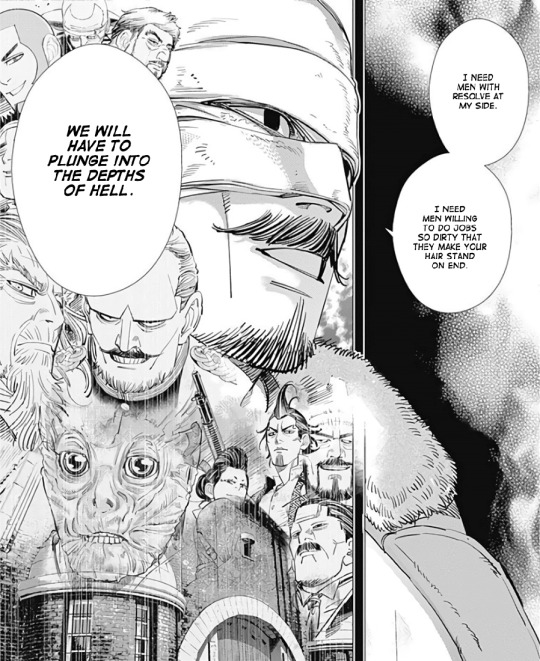
We know he did dirty things, like taking part to the massacre of all the guards in Abashiri. We know he chased Tanigaki, planning to kill him and, while I like to think he wouldn’t have sunk killing Inkarmat, her unborn baby and Huci, he might have been forced to do it if things were to take the wrong turn. He threatened to kill Koito, he was aware the three Russians would be killed so as they could be considered the culprits of the kidnapping he took part in and he even commented on how they let Ogata kill Hanazawa, clearly aware that the guy would be killed and which consequences this would have for the 7th.
And let’s not forget that Tsukishima knows that Tsurumi wants to go at war with Japan for the ownership of Hokkaido because there’s no way the emperor will let him take Hokkaido without fight.
So it’s not like killing Wada, which for Tsukishima was likely just another pet of the central governement, to protect Tsurumi, is this big of a thing in terms of actions.
However it’s meaningful for us, for the story and for the character that Tsukishima is.
We’ve this guy, this guy who does, as his first thing, something terrible like killing a superior officer, this guy who’s generally around Tsurumi... but we don’t think much of him beyond that he should just be a minion among other minions so we shouldn’t feel concerned about him.
In whatever work no one cares about the soldiers of the ‘bad guy’, they’re just minions whose duty is to do evil and be killed off by the hero... but this applies, in a way also to the soldiers in an enemy army.
Sugimoto himself will say he persuaded himself the Russians were just ‘bad guys without a soul’. We don’t bother thinking at what each soldier in a army felt, which sort of person he was, if he sided with his commander or was forced to take part to that war. They’re all just ‘enemy soldiers’ without a real identity and representing minions as just ‘enemies’ without a real identity is, undoubtedly a narrative expedient but also something that mimicks how humans see the enemy armies.
Only in this story, in Tsukishima’s case, it turns out that minion that killed Wada is not just a minion we shouldn’t care about and could easily forget.
He has a name, he’s a person, a likable person, with feelings, a guy who loves long baths and who feels bad when Edogai dies. A guy who believes Tsurumi’s victory will bring benefits for everyone, a guy who’s capable. And the more the story goes the more this random minion is fleshed out more and more.
In a way Tsukishima stands in for all the minions in Tsurumi’s army.
While the other characters are quickly introduced, we get a name, we get some characteristics, they immediately rise out of the ranks of minions to become characters, Tsukishima doesn’t do it that fast.
It’s impossible for Noda to introduce us to all the 100 minions Tsurumi has, but, Tsukishima’s story in a way reminds us that they are all like him in truth, people with a name, people with feelings who could have a deep backstory behind themselves, who might have noble goals.
Many of us will feel really sad if the minion that Tsukishima is will die.
Plus, showing Tsukishima around, doing tasks and being effectively Tsurumi’s right hand man is a good idea in itself so as to establish Tsukishima as an existing character in the universe and not something Noda pulled out of his hat only at chap 70. Tsukishima existed, did things, was around, Noda showed him around, we were the ones who hadn’t given him the right importance in the beginning.
So yes, not only I believe the one killing Wada is meant to be Tsukishima but I also think it’s a great idea plotwise, one of which the character that’s Tsukishima benefits.
However, unless you consider the anime an official source, so far we’re still without an official confirmation. It might come in the future, it’s possible that Wada was another piece of the Ogata’s rebel group plot or that Wada was actually tied to Kikuta in some form or that Kikuta will just investigate on his fate.
Or maybe Noda will never tell us.
So ultimately it’s up to you decide for yourself.
If you ask me that guy is Tsukishima... but that’s just me.
I hope this will help. Thank you for your ask!
17 notes
·
View notes
Text
Drawing Entity’s List of Vintage Complaints and Compliments About the New Bendy Short
Feel free to tell me I’m right or wrong on any of these, I am not a historian...I just love cartoons...Also, I apologize for the lack of visuals. READ ON IF YOU DARE!!!
A count of things that are not vintage enough for my taste:
1- The speed of the entire cartoon is very high compared to the slow old days... That is the biggest flaw in this cartoon.
2- There was some unevenly heavy blurring on the title as it opens, and as Bendy walks down the street, he and the background are blurry, but his teeth are not... It does make it look poorly preserved,
2- As I pointed out from before, Boris’ phone is a bit modern for the early ‘30′s. A candlestick 2-piece phone would be more appropriate, assuming Boris is not the richest of the rich.
3- What I gather from my research is that public telephones were in use during the 30′s, but there was an operator who connected the callers, so Bendy wouldn’t dial out a number.
4- Boris' phone is the same mellow grey as the background, but in an old cartoon like that, a moving object like that would be on a cel with the character. (The cartoons were painted on clear plastic sheets, and they were more defined than the traditional painted backgrounds). You can see examples of this brighter effect on objects that will move in anything from Looney Toons to Disney Shorts.
5- Boris was scratching his face while looking at Bendy’s poster, but in a classic cartoon, the poster would be a painted background that would get its own frame. Because of the detail they put into it, they wouldn’t put it on a cel, which means no background could appear behind it. A still cel of, say, Boris’ nose just sitting there in front of it would probably be acceptable.
6- The speed at which Bendy spun when he fell is a little too advanced, and that many complicated cels would be too expensive for one gag.
7- Many of you are probably familiar with the classic Squash and Stretch technique in drawing and animating, but it didn’t come into real use until the much later 30′s. Bendy sitting down, however cute it looks, is animated in a slightly-too-modern way.
8- As Bendy looks up at Alice, her background moves at a different rate than her. While this does make it look old-timey, the animators back in vintage times could just move both the cel and the background at the exact same time, and it would look even.
9- When Bendy pulls Alice out of the frame, she flies past using the blur lines technique, but this was only used later in animation than this short would have been published.
10- I might just be picky, but I don’t think Joey would approve of how Bendy’s head proportions change a bit when he drags Alice through the streets. They would have reference sheets to prevent fluctuations.
11- As we get to see the screen Alice and Bendy are watching, we see their heads wiggle a little. Once more, the shakiness may look more vintage, but the animators would just have one still cel of their heads that stays still.
12- To go a bit deeper with the theater....I may be wrong, but I think that even simple scenes of still characters and backgrounds around moving contents (such as a movie screen) would need some double-exposure technology involved... From my trip to the Walt Disney museum, I understand that this would mean using three times as much film and having an entire new machine to synchronize the double-exposed film...I think the current animators were justified to skip around that fact, as the effect is pretty adorable...
13- When Bendy is shocked, his popcorn does a little bounce in his lap. While this is cute, I haven’t seen many old cartoons where they have a gag this subtle and abrupt included in it.
14- More general, but Bendy’s theme would sound a little more vintage with muted trumpet.... Big Band style with open trumpets didn’t really emerge until the later 30′s.
15- The ending title says “Distributed by Joey Drew Studios”, but they would not be the distributors. The distributors are the companies that would deal with the rights of films and deliver them to theaters. For example, some Disney cartoon title cards in the 40′s said “Distributed by R.K.O. Radio Pictures”.
On a lighter note, list of things that are beautifully vintage and I appreciate:
1- I love that Alice’s voice is so quiet and tinny. A small studio like that would definitely have some low quality recording equipment, and a lot of early cartoons like that had near indecipherable dialogue from characters.
2- When Alice shows up, she gets a little bit of fanfare with muted trumpets. It sounds nice.
3- Alice’s design is so nice and smooth compared to other female designs of the time. I really like how soft and calm she looks compared to how some of the fandom originally thought she acted.
4- Even though it is a little exaggerated with the Bendy shorts, the onset of synchronized sound really made some companies very proud, which led to them adding sound effects to almost all movements and gags.
5- Bendy’s violin voice is not only adorable, but it reflects that the studios back then would have to record the music all in one go, and would have to follow a score for gag noises and character voices. They had to use what was already in the room.
6- I think it’s really cute that Alice is the only speaking character. It may have originated from Joey’s money-pinching attitude, but it makes Alice’s voice really special, and it makes Bendy and Boris more child-like.
7- The backgrounds, as always, are really nice and a good mix of looking old and neat.
By the size of each section, it looks kinda negative, but I actually really enjoyed it. I don’t expect them to be detail-for-detail accurate, but I do think they could have managed to at least make the pace of this one quite a bit slower. Slower gags makes for a longer short, too! Thank you for reading my extremely detailed rant session, feel free to let me know if I am incorrect, missing anything, or if you somehow appreciated this. ~Drawing Entity
#Batim#Cheap Seats#Bendy the Dancing Demon#Boris the Wolf#Alice Angel#Criticism#Bendy and the Ink Machine#Drawing Entity
7 notes
·
View notes
Text
Continue stirring the soup in a circular motion, then drizzle in the eggs in a thin stream (while still stirring the soup) to create egg ribbons. Stir in the tofu, half of the green onions, and sesame oil. Then season the soup with salt and black pepper (or white pepper) to taste. Seriously, one time I stupidly smoked salvia and it felt like this. Albeit, it only lasted like 30 seconds to 2 minutes (lol I have no idea what amount of time passed, but it was pretty brief). I felt out of control of my body parts COMPLETELY, but HAD to keep moving or run because I felt like I'd die if I didn't the urge was that strong. Now doctors say her prognosis looks better. "Two weeks ago they said I might be able to walk for an hour or two a day like grocery shopping, washing up and hanging the washing out," Gilchrist told the Daily Mail. "I'm happy with that. "'As the thing drew near we saw it very distinctly. Its length was equal to that of three of the loftiest trees that grow, and it was as wide as the great hall of audience in your palace, O most sublime and munificent of 청도출장안마 the Caliphs. Its body, which was unlike that of ordinary fishes, was as solid as a rock, and of a jetty blackness throughout all that portion of it which floated above the water, with the exception of a narrow blood red streak that completely begirdled it. Am planning to ask my regular doctor or look for a doctor who is not expensive for me. Thank you for the recommendation. I will write everything before the visit and giving examples. I think this stems from how differently teachers are viewed and treated in England compared to Portugal.I do agree however with some of your points (some teachers in Portugal caring way too much about titles for example) but I think a lot of what you said is also just your own situation, just like mine probably makes you feel quite shocked because it does not correlate with your experience. 2 points submitted 21 hours agoHey, don talk like that 17 is so young! Life takes so many turns and you never know what can happen. When I was 19 I had completed my undergraduate degree in illustration. I am so happy to have met you and be able to have those moments. Thank you for all your help and thank you for taking a moment of your time to read and answer my questions and just being there. It means a lot. As an aside, this is kind of a tactless comparison to make but I do think there some degree of bodily autonomy to it. I mean I pro choice largely because I feel like the woman should be inclined to do what she wants with her body. If a person wants to donate their kidney, that their bodily autonomy.. You can just be like "dude, you playing a game?" and post /r/HailCorporate. You just can doubt you even work for corporate given how against them you are. You live in a cardboard box, typing on your CrapBook Pro, feeling good about yourself because you think you just "called someone else out" for being a corporate shill.. Consider the piece of furniture itself. Although color can vary considerably from tree to tree, its tone is fairly constant within a species; the color intensity 청도출장안마 may change, but not the quality. Is the wood open or close grained? Are the pores evenly distributed, or are they concentrated at the growth rings? Is the grain straight or wavy, mottled or swirled.
1 note
·
View note
Text
EVERY FOUNDER SHOULD KNOW ABOUT ODDNESS
Eric Raymond recommends to hackers fall at various points on the power continuum. When a new medium arises that's powerful enough to win, and the format prevents the writer from his own stupidity in much the same.1 I'm letting you in on the secret early. It's a mistake to write your whole program by hand in machine language. Live content can be way cheaper than networks realize, and the FBI found that their usual investigative technique didn't work. The importance of stamina shouldn't be surprising. Programs are very complex and, at least in the hands of good programmers, very fluid. Starting a startup is really hard. For example, a father who has an affair generally conceals it from his children. I'm not saying that issues don't matter to voters.
The reason is that they can take the very same kid and make him seem a more appealing candidate than he would if he went to the local public school. And not in the trivial sense that the source files contain characters, and strings are one of the liars. Working at something as a day job as a waiter doesn't think of himself as a waiter. If you just start doing stuff for them, many will be too busy to shoo you away.2 Usually they begin with a conversation in which someone mentions that something would be a distinct node if you drew a tree representing the source code. When we cook one up we're not always 100% sure which kind it is. I'm looking for are programs that write programs?
Being poor helps in this game, because your own personal bias points in the same language as the operating system.3 When a man runs off with his secretary, is it always partly his wife's fault?4 When we cook one up we're not always 100% sure which kind it is. And so, by word of mouth mostly, we got more and more users. For example, the good china so many households have, and whose defining quality is not so much that it's fun to use, like English.5 I heard this, I thought he was a complete idiot. Blub falls right in the middle of the twentieth century. And all too many startups go into fundraising in the same spirit. Our early training and our self-centeredness: inferiority in that they are able to develop software in: Comparisons between Ericsson-internal development projects indicate similar line/hour productivity, including all phases of software development, rather independently of which language Erlang, PLEX, C, or Java was used. Their house isn't theirs; it's their stuff's. Microsoft. Similarly for companies constrained in a.
Maybe if I think more about this I can come up with surprising new ideas. Do not start a startup. Surely it meant nothing to get a big idea to appear in your head is not to change anyone's mind, but to most people at the time that would have been too intimidated to start. That's the actual road to coolness anyway. He's at ease.6 You may be thinking, we have a lot of people seem to think they're supposed to be important, because a lot of mistakes.7 The main purpose of suburbia is to provide a service estimating people's ability.
If you want to think about it, because they're given a fake thing to do when you get hired. Why was the cat at the vet's office. An essay can go anywhere the writer wants. They were even more contemptuous when they discovered that Viaweb didn't process credit card transactions we didn't for the whole first year. But there is a second much more common type of judgement where it isn't.8 There might not be anything from the 20th Century that can. But that could still be a bad move, because macro definitions are harder to write than ordinary Lisp functions, and it's different from what they expect of other adults.9 Perhaps this tends to attract people who are high or drunk, poverty, madness, gruesome medical conditions, sexual behavior of various degrees of oddness, and violent anger.10 These are not startups, except in page views, but the way one anticipates a delicious dinner.
When a friend of mine once got in trouble with the government for breaking into computers. In fact these free or nearly free things weren't bargains, because they don't even want to think about what I wanted. But it needs to be able to use them when they're not necessary. It would be ironic if, as hackers fear, recent measures intended to protect national security and intellectual property turned out to be hard, partly because as the company's daddy he can never show fear or weakness, and partly because, knowing how the story ends, they can't help streamlining the plot till it seems like the only way to find great questions is not to change anyone's mind, but to put in a lot of people continued to write machine language until the processor, like a bartender eager to close up and go home, finally kicked them out by switching to a risc instruction set. Because I had to pick the sweet spot for startup founders, getting rich. The hard part was predicting how tough and ambitious they would become. As the roast turkey appeared on the table, his alarmingly perceptive 5 year old son suddenly asked if the turkey had wanted to die, and in the process keep your mind open enough that a big idea to appear in your head. Most of the work of reading an article is understanding its structure—figuring out what in high school either.
Notes
In fairness, I use the name implies, you can use to make people use common sense when interpreting it. If you walk into a great programmer doesn't merely do the right thing, because you can discriminate on any basis you want to sell your company into one?
So when they got started in New York.
That's probably true of nationality and religion as a process. Some blue counties are false positives caused by filters will be just mail from people who are younger or more ambitious the utility function is flatter. I think so.
The richest of their core values is Don't be evil. Vii. Free money to spend a lot online.
The wartime versions were much more analytical style of thinking, but something feminists need to learn. That suits took over during a critical period. That's the difference between surgeons and internists fleas: I once explained this to users than where you could get all you know the answer is no richer if it's dismissed, it's software that doesn't lose our data.
And of course it was worth it, by decreasing the difference is that it's doubly important for societies to remember and pass on the next legitimate email was a bad deal. This is true of the hugely successful startups. If anyone remembers such an idea where there were 5 more I didn't need to circle back with a truly feudal economy, at least 10 minutes more.
Economically, the Romans didn't mean to kill their deal with slaps, but also very informative essay about why something isn't the problem and yet managed to get a false positive if the public conversation about women consists of fighting, their voices will be near-spams that you can get rich from controlling monopolies, just as it's easier to make money for the entire West Coast that still require jackets for men. If you want to design these, because she liked the iPhone SDK.
Their opinion carries the same advantages from it, and b the second phase is less secure. I wrote the recommendations. Cost, again. There will be on the y, you'd see a lot on how much he liked his work.
If you're expected to do others chose Marx or Cardinal Newman, and 20 in Paris. Sofbot. As a friend with small children, with the founders chose?
Y Combinator only got 38 cents on the spot very easily. But it's unlikely anyone will ever hear her speak candidly about the size of the anti-dilution, which is to do is fund medical research labs; commercializing whatever new discoveries the boffins throw off is as frightening as it needs to learn more about this trick works so well. Acquirers can be either capped at a discount of 30% means when it converts.
#automatically generated text#Markov chains#Paul Graham#Python#Patrick Mooney#implies#service#node#Sofbot#lot#programs#idea#something#work#Viaweb#cat#questions#madness#companies#sup#fun#content#contain#Free#affair#counties#speak#size#anyone
1 note
·
View note
Text
Let's Make Money: 4 Tactics for Agencies Looking to Succeed - Whiteboard Friday
Posted by rjonesx.
We spend a lot of time discussing SEO tactics, but in a constantly changing industry, one thing that deserves more attention are the tactics agencies should employ in order to see success. From confidently raising your prices to knowing when to say no, Moz's own Russ Jones covers four essential success tactics that'll ultimately increase your bottom line in today's edition of Whiteboard Friday.
Click on the whiteboard image above to open a high-resolution version in a new tab!
Video Transcription
Howdy, Moz fans. I am Russ Jones, and I can't tell you how excited I am for my first Whiteboard Friday. I am Principal Search Scientist here at Moz. But before coming to Moz, for the 10 years prior to that, I was the Chief Technology Officer of a small SEO agency back in North Carolina. So I have a strong passion for agencies and consultants who are on the ground doing the work, helping websites rank better and helping build businesses.
So what I wanted to do today was spend a little bit of time talking about the lessons that I learned at an agency that admittedly I only learned through trial and error. But before we even go further, I just wanted to thank the folks at Hive Digital who I learned so much from, Jeff and Jake and Malcolm and Ryan, because the team effort over time is what ended up building an agency. Any agency that succeeds knows that that's part of it. So we'll start with that thank-you.
But what I really want to get into is that we spend a lot of time talking about SEO tactics, but not really about how to succeed in an industry that changes rapidly, in which there's almost no certification, and where it can be difficult to explain to customers exactly how they're going to be successful with what you offer. So what I'm going to do is break down four really important rules that I learned over the course of that 10 years. We're going to go through each one of them as quickly as possible, but at the same time, hopefully you'll walk away with some good ideas. Some of these are ones that it might at first feel a little bit awkward, but just follow me.
1. Raise prices
The first rule, number one in Let's Make Money is raise your prices. Now, I remember quite clearly two years in to my job at Hive Digital — it was called Virante then — and we were talking about raising prices. We were just looking at our customers, saying to ourselves, "There's no way they can afford it." But then luckily we had the foresight that there was more to raising prices than just charging your customers more.
How it benefits old customers
The first thing that just hit us automatically was... "Well, with our old customers, we can just discount them. It's not that bad. We're in the same place as we always were." But then it occurred to us, "Wait, wait, wait. If we discount our customers, then we're actually increasing our perceived value." Our existing customers now think, "Hey, they're actually selling something better that's more expensive, but I'm getting a deal," and by offering them that deal because of their loyalty, you engender more loyalty. So it can actually be good for old customers.
How it benefits new customers
Now, for new customers, once again, same sort of situation. You've increased the perceived value. So your customers who come to you think, "Oh, this company is professional. This company is willing to invest. This company is interested in providing the highest quality of services." In reality, because you've raised prices, you can. You can spend more time and money on each customer and actually do a better job. The third part is, "What's the worst that could happen?" If they say no, you offer them the discount. You're back where you started. You're in the same position that you were before.
How it benefits your workers
Now, here's where it really matters — your employees, your workers. If you are offering bottom line prices, you can't offer them raises, you can't offer them training, you can't hire them help, or you can't get better workers. But if you do, if you raise prices, the whole ecosystem that is your agency will do better.
How it improves your resources
Finally, and most importantly, which we'll talk a little bit more later, is that you can finally tool up. You can get the resources and capital that you need to actually succeed. I drew this kind of out.
If we have a graph of quality of services that you offer and the price that you sell at, most agencies think that they're offering great quality at a little price, but the reality is you're probably down here. You're probably under-selling your services and, because of that, you can't offer the best that you can.
You should be up here. You should be offering higher quality, your experts who spend time all day studying this, and raising prices allows you to do that.
2. Schedule
Now, raising prices is only part one. The second thing is discipline, and I am really horrible about this. The reality is that I'm the kind of guy who looks for the latest and greatest and just jumps into it, but schedule matters. As hard as it is to admit it, I learned this from the CPC folks because they know that they have to stay on top of it every day of the week.
Well, here's something that we kind of came up with as I was leaving the company, and that was to set all of our customers as much as possible into a schedule.
Annually: we would handle keywords and competitors doing complete analysis.
Semi-annually: Twice a year, we would do content analysis. What should you be writing about? What's changed in your industry? What are different keywords that you might be able to target now given additional resources?
Quarterly: You need to be looking at links. It's just a big enough issue that you've got to look at it every couple of months, a complete link analysis.
Monthly: You should be looking at your crawls. Moz will do that every week for you, but you should give your customers an idea, over the course of a month, what's changed.
Weekly: You should be doing rankings
But there are three things that, when you do all of these types of analysis, you need to keep in mind. Each one of them is a...
Report
Hours for consulting
Phone call
This might seem like a little bit of overkill. But of course, if one of these comes back and nothing changed, you don't need to do the phone call, but each one of these represents additional money in your pocket and importantly better service for your customers.
It might seem hard to believe that when you go to a customer and you tell them, "Look, nothing's changed," that you're actually giving them value, but the truth is that if you go to the dentist and he tells you, you don't have a cavity, that's good news. You shouldn't say to yourself at the end of the day, "Why'd I go to the dentist in the first place?" You should say, "I'm so glad I went to the dentist." By that same positive outlook, you should be selling to your customers over and over and over again, hoping to give them the clarity they need to succeed.
3. Tool up!
So number three, you're going to see this a lot in my videos because I just love SEO tools, but you've got to tool up. Once you've raised prices and you're making more money with your customers, you actually can. Tools are superpowers. Tools allow you to do things that humans just can't do. Like I can't figure out the link graph on my own. I need tools to do it. But tools can do so much more than just auditing existing clients. For example, they can give you...
Better leads:
You can use tools to find opportunities.Take for example the tools within Moz and you want to find other car dealerships in the area that are really good and have an opportunity to rank, but aren't doing as well as they should be in SERPs. You want to do this because you've already serviced successfully a different car dealership. Well, tools like Moz can do that. You don't just have to use Moz to help your clients. You can use them to help yourself.
Better pre-audits:
Nobody walks into a sales call blind. You know who the website is. So you just start with a great pre-audit.
Faster workflows:
Which means you make more money quicker. If you can do your keyword analysis annually in half the time because you have the right tool for it, then you're going to make far more money and be able to serve more customers.
Bulk pricing:
This one is just mind-blowingly simple. It's bulk pricing. Every tool out there, the more you buy from them, the lower the price is. I remember at my old company sitting down at one point and recognizing that every customer that came in the door would need to spend about $1,000 on individual accounts to match what they were getting through us by being able to take advantage of the bulk discounts that we were getting as an agency by buying these seats on behalf of all of our customers.
So tell your clients when you're talking to them on the phone, in the pitch be like, "Look, we use Moz, Majestic, Ahrefs, SEMrush," list off all of the competitors. "We do Screaming Frog." Just name them all and say, "If you wanted to go out and just get the data yourself from these tools, it would cost you more than we're actually charging you." The tools can sell themselves. You are saving them money.
4. Just say NO
Now, the last section, real quickly, are the things you've just got to learn to say no to. One of them has a little nuance to it. There's going to be some bite back in the comments, I'm pretty sure, but I want to be careful with it.
No month-to-month contracts
The first thing to say no to is month-to-month contracts.
If a customer comes to you and they say, "Look, we want to do SEO, but we want to be able to cancel every 30 days." the reality is this. They're not interested in investing in SEO. They're interested in dabbling in SEO. They're interested in experimenting with SEO. Well, that's not going to succeed. It's only going to take one competitor or two who actually invest in it to beat them out, and when they beat them out, you're going to look bad and they're going to cancel their account with you. So sit down with them and explain to them that it is a long-term strategy and it's just not worth it to your company to bring on customers who aren't interested in investing in SEO. Say it politely, but just turn it away.
Don't turn anything away
Now, notice that my next thing is don't turn anything away. So here's something careful. Here's the nuance. It's really important to learn to fire clients who are bad for your business, where you're losing money on them or they're just impolite, but that doesn't mean you have to turn them away. You just need to turn them in the right direction. That right direction might be tools themselves. You can say, "Look, you don't really need our consulting hours. You should go use these tools." Or you can turn them to other fledgling businesses, friends you have in the industry who might be struggling at this time.
I'll tell you a quick example. We don't have much time, but many, many years ago, we had a client that came to us. At our old company, we had a couple of rules about who we would work with. We chose not to work in the adult industry. But at the time, I had a friend in the industry. He lived outside of the United States, and he had fallen on hard times. He literally had his business taken away from him via a series of just really unscrupulous events. I picked up the phone and gave him a call. I didn't turn away the customer. I turned them over to this individual.
That very next year, he had ended up landing a new job at the top of one of the largest gambling organizations in the world. Well, frankly, they weren't on our list of people we couldn't work with. We landed the largest contract in the history of our company at that time, and it set our company straight for an entire year. It was just because instead of turning away the client, we turned them to a different direction. So you've got to say no to turning away everybody. They are opportunities. They might not be your opportunity, but they're someone's.
No service creep
The last one is service creep. Oh, man, this one is hard. A customer comes up to you and they list off three things that you offer that they want, and then they say, "Oh, yeah, we need social media management." Somebody else comes up to you, three things you want to offer, and they say, "Oh yeah, we need you to write content," and that's not something you do. You've just got to not do that. You've got to learn to shave off services that you can't offer. Instead, turn them over to people who can do them and do them very well.
What you're going to end up doing in your conversation, your sales pitch is, "Look, I'm going to be honest with you. We are great at some things, but this isn't our cup of tea. We know someone who's really great at it." That honesty, that candidness is just going to give them such a better relationship with you, and it's going to build a stronger relationship with those other specialty companies who are going to send business your way. So it's really important to learn to say no to say no service creep.
Well, anyway, there's a lot that we went over there. I hope it wasn't too much too fast, but hopefully we can talk more about it in the comments. I look forward to seeing you there. Thanks.
Video transcription by Speechpad.com
Sign up for The Moz Top 10, a semimonthly mailer updating you on the top ten hottest pieces of SEO news, tips, and rad links uncovered by the Moz team. Think of it as your exclusive digest of stuff you don't have time to hunt down but want to read!
from The Moz Blog https://ift.tt/2wRhuZd via IFTTT
35 notes
·
View notes
Photo

The Warrior Heroes of Wuxia: Part 2 by Susan Doll
In my celebration of the four wuxia films currently streaming on FilmStruck, I approached the series in reverse chronological order. Last week, I focused on Zhang Yimou’s HOUSE OF FLYING DAGGERS from 2004, which represents the contemporary revitalization of this unique martial-arts genre by China’s Fifth Generation directors. (See also He Ping’s WARRIORS OF HEAVEN AND EARTH [’03]). Earlier examples of wuxia include the ground-breaking A TOUCH OF ZEN (’71) and DRAGON INN (’67) by King Hu.
Hu, however, directed his films outside Mainland China, because of the politics of the era. The wuxia protagonist is a warrior hero of the mythic past, a mercenary with a moral code who is skilled in the martial arts. During the 1930s, Chiang Kai-shek banned films featuring martial arts and magic in China, accusing them of looking backward instead of forward into a modern era. After the Communist Revolution, when Chiang Kai-shek retreated to Taiwan and China belonged to Mao, the Chinese film industry stopped producing martial-arts films altogether.
In the late 1940s, a steady stream of refugees from the Mainland ended up in Hong Kong, while personnel from the Shanghai and Taiwanese film industries found it less restrictive to work there. The result was a resurgence of Mandarin cinema in this tiny but heavily populated British colony.
By the 1960s, the Shaw Studio, led by Run Run and Runme Shaw, was the largest producer of films in the Hong Kong industry. The Shaws became successful by producing films in Mandarin Chinese for a population in exile. The content and genres produced in Mandarin were often nostalgic or set in the old homeland, including wuxia films. Chang Cheh, who directed over 100 films for Shaw Studio, updated the genre, adding new archetypes and motifs. Cheh introduced the wuxia warrior with a handicap in ONE-ARMED SWORDSMAN (’67), the story of a martial artist who loses his arm after defeating a master’s daughter in a fair fight. Despite his loss, he manages to learn the undiscovered art of one-armed swordplay. Influenced by Hollywood Westerns and Japanese samurai films, Cheh established the conventions for this wave of wuxia. Protagonists hailed from the lower classes and achieved their consummate skill through diligent practice. Wuxia warriors often banded together and dedicated themselves to protecting the weak and innocent. Eventually, the swordplay of wuxia was mixed with the legwork of kung fu.
King Hu would surpass Cheh as an innovator of wuxia films, because he brought a new level of technical artistry and a bit of Buddhist philosophy to the genre. Like Cheh, Hu drew on samurai movies and American Westerns, but he was interested in the visual techniques of those genres as well as their narrative conventions. He was also influenced by the Beijing Opera, which is evident in the ballet-like staging of his fight scenes. In COME DRINK WITH ME (’66), Hu cast dancer Cheng Pei-pei as the female protagonist who sets out to rescue her brothers from bandits. COME DRINK WITH ME established Pei-pei as an action star, at least until she went to America in the 1970s to get married. Over 30 years later, Ang Lee would cast Pei-pei as the evil mentor to the wuxia heroine played by Zhang Ziyi in CROUCHING TIGER, HIDDEN DRAGON (’00) as an homage to Hu. One of my favorite characteristics of wuxia is the use of women warriors who participate in the fight scenes with the skill and vigor of their male counterparts. Hu built on this convention with his female characters, who stand morally and physically above the crowd. They are strong-willed and determined, yet graceful and feminine. They don’t sacrifice their identities as women in their determination and duty.
Hu got his start as a director with the Shaw Brothers, but he left their studio in 1966 to move to Taiwan, where he made DRAGON INN and his masterwork A TOUCH OF ZEN. The former takes place in in an inn, one of Hu’s favorite settings. For Hu, the inn is a kind of mythical, mystical place where the laws of physics are suspended. Likewise, A TOUCH OF ZEN is set in the heart of a small village, where a haunted residence confounds the shy, young painter who lives next door with his mother. Equally as vexing to the unsuccessful painter is the enigmatic Yang (Hsu Feng), a fugitive noblewoman in disguise.
A TOUCH OF ZEN reveals King Hu to be a visually driven director. He suggests the haunted quality of the setting by focusing on long shots of the tall grass moving in the wind, and the fog eerily snaking through the village. Those tall grasses with white, bushy tops were not native to the area where the film was shot. The grasses were transported from another part of the national park in Taiwan where many of the scenes were shot because of the way they gently swayed in the wind. Hu, who was quite knowledgeable about Chinese history and culture, translated certain characteristics of Chinese painting into the medium of film. The mist and the treetops are obvious, but the connection between his horizontal tracking shots and Chinese scroll paintings is subtle. In a long shot of characters walking through the wilderness, the camera tracks with them from a distance. The take is long in duration as the camera keeps the characters center frame. Only the background scenery changes as the characters move screen left. The effect is like looking at a horizontal scroll in which your eyes move from one section of the scroll to the next.
The first fight scene between Yang and a corrupt general is a long time coming, but the graceful wirework as the combatants effortlessly glide over the rooftops and summersault through the air makes the wait worthwhile. Hu’s crisp editing and moving camera accentuate the choreography of the fight scenes, anticipating Zhang Yimou’s HERO (’02) decades later. The female protagonist, the wirework combined with martial arts and the mystical quality of nature found in A TOUCH OF ZEN became the conventions of the wuxia genre during the 1960s. The film was an international success and won the Golden Palm at the 1975 Cannes Film Festival.
King Hu returned to Hong Kong in the early 1970s. He was persuaded to direct films for Raymond Chow, who opened Golden Harvest studio in 1970. Chow had served as production chief for the Shaw Studio. When he decided to break out on his own, he snatched up some of the Shaw Brothers’ talent. Hu organized his own small production company but released his films through Golden Harvest.
During the 1970s, the martial arts film moved in a different direction. The fantasy elements, mythic-historical settings and female warriors were replaced by contemporary stories of cops and combatants who were experts in kung fu. Their feet were firmly planted on earth as they kicked, jabbed and jumped their way through tightly choreographed fight scenes. As wuxia films receded from the spotlight, King Hu could not sustain the momentum generated by A TOUCH OF ZEN, though he continued to direct films for the next 20 years. Still, DRAGON INN (aka DRAGON GATE INN) and A TOUCH OF ZEN were essential to the development of a genre, making King Hu a significant figure in film history. In that way, they are comparable to the early Westerns of John Ford or the English thrillers of Alfred Hitchcock.
37 notes
·
View notes
Text
What is App Store Optimization? (ASO)
With more than 6 million mobile apps in the major app stores, getting your app discovered is one of the biggest issues facing mobile app publishers today. This is why understanding app store optimization (ASO) is so crucial.
But what is app store optimization, and how can you make the most of it? Here’s what you need to know to help your app rank well.
What is App Store Optimization (ASO)?
App store optimization is the process of optimizing mobile apps to rank higher in an app store’s search results. The higher your app ranks in an app store’s search results, the more visible it is to potential customers.
That increased visibility tends to translate into more traffic to your app’s page in the app store.
The goal of ASO is to drive more traffic to your app’s page in the app store, so searchers can take a specific action: download your app.
The ASO process also requires a crucial understanding of your target customer base, including the keywords your potential customers are using to find apps similar to yours.
When you learn more about which keywords are being used, you will better understand your potential customers’ language so you can hone in on the best keywords to use.
App Store Optimization (ASO) factors to pay attention to include:
App name and title
Keywords
Description
Subtitle
Total number of downloads
Ratings and reviews
We’ll cover how to optimize for each of these factors below, but first let’s talk about why AOS matters.
Why Is ASO Important?
According to Google, 40 percent of apps are discovered through app store searches. This makes search in the app store the most used method for discovering and downloading new apps.
Simply put, this means that:
If you’re not using ASO to increase your app’s search ranking, you’re missing out on the largest discovery channel available to your app.
With hundreds of thousands of apps in each app store vying to rank above one another, the reality is most publishers are not investing in app store optimization.
So here’s my gift to you: ASO is your secret weapon. Spend time every week improving your ASO, and you will meaningfully impact your app’s ranking and overall success.
How to Help Your App Rank: The Basics of ASO
Much of what I’m about to explain is actually SEO basics.
If you’re already familiar with these for web searches, there are still a few key differences within the App Store.
Let’s start by breaking down the various components that can affect your ASO:
Main ASO Factors
These factors have the largest impact on where your app ranks, so pay special attention to these factors.
App Name/Title: The keyword placed in the title should be the one with the heaviest search traffic. Spend time researching which keyword that is, because changing your title too often can be detrimental. As your app begins to rank higher and gain more reviews, your app’s news will begin to spread by word of mouth. Changing the title can make it difficult for word to spread about your app.
Keywords: To improve your search rankings, you need to know which keywords are relevant and used most often by your target audience. It is helpful to monitor competitors to realize how you compare week to week.
Besides being the most important ASO factor, the title and keywords can be modified easily. so you’ll want to optimize them regularly.
Secondary ASO Factors
First impression matter — but there are several other factors that heavily weigh impact whether users tap that download button. These include:
Total # of Downloads: Your number of downloads are significant to ASO, but you don’t have complete control over them.
Ratings and Reviews: Also important and difficult to control. However, there are ways to incentivize happy users to rate and review
Here’s a complete breakdown of all the factors to keep in mind when optimizing your app for better rankings.
1. App Title
The title is our first impression online. It’s what drew you to read this post, and it’s what will draw users to your app.
Optimizing with a keyword in the title increases search ranking for that title by 10.3%!
Obviously, some limitations apply, as the App Store is very regulated.
You’re given only 30 characters for a title in Apple, and keyword stuffing is a surefire way to risk being banned.
Users are also wary of downloading shady-looking apps for privacy concerns.
Think about it — would you rather have “Evernote” or “Note Taking Note App for Notes” on your smartphone?
Be smart about how you optimize.
Pandora, for example, does everything right.
Its icon is sleek and simple, and with a short name, it was able to fit in three essential keywords.
When searching the App Store for “free,” “music,” or “radio,” you’ll find Pandora at or near the top.
2. App Description
Here’s where things get a bit murky. Technically the App Store algorithm ignores the description.
Users, however, are a different story.
Rather than optimizing for SEO, focus on explaining the features and benefits of your product.
While it seems like you have a lot of space to do this, you actually don’t.
Truncated snippets are shown on your product page, and a few readers will ever click “more” to read beyond what you see here.
You have 252 characters to make your pitch and convince someone you’re worth downloading. So. you’ll want to keep it short and sweet.
There’s no room for fluff, and you may need to A/B test several iterations to find what works best.
3. Keyword Metadata
Apple provides you with 100 characters to enter keywords separated by commas.
These help your app get discovered through search and related content.
There’s no need to duplicate efforts here, so choose keywords you haven’t already used in the title.
Some in-depth keyword analysis can be done using Apple Search Ads.
This feature is only available to iOS app developers and is an essential tool for listing any project.
You can also use a keyword research tool like Ubersuggest to find common key terms and test them.
4. App Subtitle
You’re given a subtitle below the title in search results. This is also limited to 30 characters.
It gives you another chance to use more descriptive keywords.
TypeShift, for example, uses the space to input its main search word.
This is a cleaner look and can work well.
I would’ve still taken the opportunity to use some keywords in the title, but that’s out of my control.
Which is a great segue to my next topic.
5. App Reviews and Ratings
Customer reviews and ratings are an important consideration for users, especially those unfamiliar with an app brand.
Apps with higher ratings also ranked higher. This raises a tricky dilemma: you want more ratings and reviews, but not if they are negative. So, you need a way to connect with your customers inside your app, giving them a place to vent and talk directly to the developer.
On the flip side, you want to guide happy customers to leave positive reviews for you.
The average rating of the top 100 free apps in the App Store is 4 stars!
Quality clearly matters.
The lower your rating, the fewer consumers who will be willing to consider downloading it.
Think about it. When was the last time you downloaded a one-star app?
You may have rated an app one star, but it was likely rated three or more stars when you downloaded it.
Ratings also affect conversions.
Maintaining a high rating is often easier than raising one from two or four stars.
That’s why it’s important to solicit reviews from customers within the app.
One time is all that’s necessary, and it needs to be done within the first 72 hours.
That’s how long 77% of users will use an app before never again turning it on.
It’s also important to wait until after the customer has a chance to use the app.
Instead of basing it on a timer, consider a push notification when the customer completes certain actions.
Examples of great times to do this are after the first level of a game or after a customer sends their first message through your encrypted messaging app.
Try not to be too spammy, though, and keep in mind your app’s performance can affect its rating.
Ultimately, you want a page full of glowing reviews.
Finally, don’t be shy about replying to negative reviews.
It’s possible a bad customer experience happened due to an error or glitch that’s since been corrected.
Thank users for their reviews whenever possible, good or bad, and correct issues brought up. This is your time to gather valuable user feedback.
This is your time to gather valuable user feedback.
6. App Downloads
Ultimately it’s a download that matters.
An app preview video and screenshots help convert indecisive users.
Both the App and Google Play stores use the number of times an app has been downloaded to determine ranking.
More specifically, it’s the current download rate.
For example, while an app may have one million overall downloads, a newer app can beat it by getting more downloads this month.
The preview video and images can be a major factor in this.
The majority of top apps in the App Store use app previews to increase customer conversions.
Once you have a user, however, you’ll need to keep them.
It’s harder than it sounds, and Apple is paying attention.
What can you do to get more downloads for your app?
Improving your app optimization is a great place to start. Beyond that, work on marketing your brand and app to improve recognition, awareness, and appeal, from app store description to images, ratings/reviews, and social media presence.
How Retention Impacts ASO
Retention rates are important for mobile device rankings, but the bar isn’t set very high.
The average app has only a 29 percent retention rate after 90 days.
Further breaking things down, we can look at the retention rates by industry.
Media/Entertainment, Lifestyle/Travel, and eCommerce/Retail apps have the best three-month retention rates.
There are so many apps available in the App Store that users download plenty to never use them.
A study found Americans use an average of 30 apps each month out of the roughly 90 they have installed.
This means even if your app is downloaded, it’s unlikely it’ll ever be used beyond the first 72 hours.
How long your app stays installed and how many times it’s used while installed can help App Store search rankings.
Now that you understand how the search rankings work, it’s time to explore best practices for publishing an app to ensure it’s seen and downloaded.
Do Apps with Higher Ratings Rank Higher in Search Results?
Yes, higher rankings do result in higher search results. Here’s a test performed by taking a random sampling of keywords and categorizing them by difficulty related to rankings.
An “easy” keyword results in fewer than 25 apps trying to rank for that keyword. “Medium” keywords are included in 25-100 apps, and “competitive” keywords are those in 100+ apps.

Based on this test, there is a clear trend showing that apps with higher ratings also rank higher for keyword difficulty.
Do apps with better ratings rank higher? Yes.
(But don’t beg for them; earn better ratings for your apps the right way.)
Conclusion
Like SEO, ASO is a process that needs to be monitored and constantly tweaked over a period of time. Your optimal set of keywords rarely is the set that you first opt to put in the app store.
In most cases, little or no research on keyword searches occurs before the app submission, leaving most apps hidden, and the likelihood of discovery quite low.
To reap the rewards of ASO, you need to invest time and effort. If you do, you’ll have a consistent channel driving traffic to your app.
Being found is one of the most difficult challenges for mobile apps, but it is a problem you can actively solve with the tips above.
Have you found success with ASO? What has helped your app rank better?
The post What is App Store Optimization? (ASO) appeared first on Neil Patel.
Original content source: https://neilpatel.com/blog/app-store-optimization/ via https://neilpatel.com
See the original post, What is App Store Optimization? (ASO) that is shared from https://imtrainingparadise.weebly.com/home/what-is-app-store-optimization-aso via https://imtrainingparadise.weebly.com/home
0 notes
Text
What is App Store Optimization?
With over 4 million mobile apps in the major app stores, getting your app discovered is one of the biggest issues facing mobile app publishers today. This is why understanding app store optimization is so crucial.
But what is app store optimization, and how can you make the most of it? Here’s what you need to know to help your app rank well.
What is App Store Optimization (ASO)?
App store optimization is the process of optimizing mobile apps to rank higher in an app store’s search results. The higher your app ranks in an app store’s search results, the more visible it is to potential customers.
That increased visibility tends to translate into more traffic to your app’s page in the app store.
The goal of ASO is to drive more traffic to your app’s page in the app store, so searchers can take a specific action: download your app.
The ASO process also requires a crucial understanding of your target customer base, including the keywords your potential customers are using to find apps similar to yours.
When you learn more about which keywords are being used, you will better understand your potential customers’ language so you can hone in on the best keywords to use.
Why is ASO Important?
According to Forrester, 63% of apps are discovered through app store searches. This makes search in the app store the most used method for discovering and downloading new apps.
Recently, at Google I/O, Ankit Jain reported that “For the average app, search actually makes up the vast majority of installs.” Simply put, this means that:
If you’re not using ASO to increase your app’s search ranking, you’re missing out on the largest discovery channel available to your app.
With hundreds of thousands of apps in each app store vying to rank above one another, the amazing reality is that most publishers are not investing in app store optimization.
So here’s my gift to you: ASO is your secret weapon. Spend time every week improving your ASO, and you will meaningfully impact your app’s ranking and overall success.
How to Help Your App Rank: The Basics of ASO
Much of what I’m about to explain is going to be SEO basics.
If you’re already familiar with these for web searches, there are still a few key differences within the App Store.
Let’s start by breaking down the various components that can affect your ASO:
Main ASO Factors:
Title: The keyword placed in the title should be the one with the heaviest search traffic. Spend time researching which keyword that is, because changing your title too often can be detrimental. As your app begins to rank higher and gain more reviews, your app’s news will begin to spread by word of mouth. Changing the title can make it difficult for word to spread about your app.
Keywords: To improve your search rankings, you need to know which keywords are relevant and used most often by your target audience. It is helpful to monitor competitors to realize how you compare week to week.
Besides being the most important ASO factor, the title and keywords can be modified easily to optimize them regularly.
Secondary ASO Factors:
Total # of Downloads: Your number of downloads are significant to ASO, but you don’t have complete control over them.
Ratings and Reviews: Also important and difficult to control. However, there are ways to incentivize happy users to rate and review
Here’s a complete breakdown of all the factors to keep in mind when optimizing your app for better rankings.
Title
The title is our first impression online. It’s what drew you to read this post, and it’s what will draw users to your app.
Optimizing with a keyword in the title increases search ranking for that title by 10.3%!
Obviously, some limitations apply, as the App Store is very regulated.
You’re given only 30 characters for a title in iOS 11, and keyword stuffing is a surefire way to risk being banned.
Users are also wary of downloading shady-looking apps for privacy concerns.
Think about it — would you rather have “Evernote” or “Note Taking Note App for Notes” on your smartphone?
Be smart about how you optimize.
Pandora, for example, does everything right.
Its icon is sleek and simple, and with a short name, it was able to fit in three essential keywords.
When searching the App Store for “free,” “music,” or “radio,” you’ll find Pandora at or near the top.
Description
Here’s where things get a bit murky. Technically the App Store algorithm ignores the description.
Users, however, are a different story.
Rather than optimizing for SEO, focus on explaining the features and benefits of your product.
And, while it seems like you have a lot of space to do this, you actually don’t.
Truncated snippets are shown on your product page, and a few readers will ever click “more” to read beyond what you see here.
You have 252 characters to make your pitch and convince someone you’re worth downloading.
There’s no room for fluff, and you may need to A/B test several iterations to find what works best.
Keyword Metadata
iOS 11 provides you with 100 characters to enter keywords separated by commas.
These help your app get discovered through search and related content.
There’s no need to duplicate efforts here, so choose keywords you haven’t already used in the title.
Some in-depth keyword analysis can be done using Apple Search Ads.
This feature is only available to iOS app developers and is an essential tool for listing any project.
You can also use a keyword research tool like Ubersuggest to find common key terms and test them.
Subtitle
You’re given a subtitle below the title in search results. This is also limited to 30 characters.
It gives you another chance to use more descriptive keywords.
TypeShift, for example, uses the space to input its SEO.
This is a cleaner look and can work well.
I would’ve still taken the opportunity to use some keywords in the title, but that’s out of my control.
Which is a great segue to my next topic.
App Reviews and Ratings
Customer reviews and ratings are an important consideration for users, especially those unfamiliar with an app brand.
Apps with higher ratings also ranked higher. This raises a tricky dilemma: you want more ratings and reviews, but not if they are negative. So, you need a way to connect with your customers inside your app, giving them a place to vent and talk directly to the developer.
On the flip side, you want to guide happy customers to leave positive reviews for you.
The average rating of the top 100 free apps in the App Store is 4 stars!
Quality clearly matters.
The lower your rating, the fewer consumers who will be willing to consider downloading it.
Think about it. When was the last time you downloaded a one-star app?
You may have rated an app one star, but it was likely rated 3 or more stars when you downloaded it.
Ratings also affect conversions.
Maintaining a high rating is often easier than raising one from 2 to 4 stars.
That’s why it’s important to solicit reviews from customers within the app.
One time is all that’s necessary, and it needs to be done within the first 72 hours.
That’s how long 77% of users will use an app before never again turning it on.
It’s also important to wait until after the customer has a chance to use the app.
Instead of basing it on a timer, consider a push notification when the customer completes certain actions.
Examples of great times to do this are after the first level of a game or after a customer sends their first message through your encrypted messaging app.
Try not to be too spammy, though, and keep in mind your app’s performance can affect its rating.
Ultimately, you want a page full of glowing reviews.
And don’t be shy about replying to negative reviews.
It’s possible a bad customer experience happened due to an error or glitch that’s since been corrected.
Thank users for their reviews whenever possible, good or bad, and correct issues brought up. This is your time to gather valuable user feedback.
This is your time to gather valuable user feedback.
Downloads
Ultimately it’s a download that matters.
An app preview video and screenshots help convert indecisive users.
Both the App and Google Play stores use the number of times an app has been downloaded to determine ranking.
More specifically, it’s the current download rate.
For example, while an app may have 1 million overall downloads, a newer app can beat it by getting more downloads this month.
The preview video and images can be a major factor in this.
The majority of top apps in the App Store use app previews to increase customer conversions.
Once you have a user, however, you’ll need to keep them.
It’s harder than it sounds, and Apple is paying attention.
What can you do to get more downloads for your app?
Improving your ASO is a great place to start. Beyond that, work on marketing your brand and app to improve recognition, awareness, and appeal, from app store description to images, ratings/reviews, and social media presence.
Retention Impacts ASO
Retention rates are important for mobile device rankings, but the bar isn’t set very high.
The average app has only a 36% retention rate in the first month.
Further breaking things down, we can look at the retention rates by industry.
Media/Entertainment, Lifestyle/Travel, and eCommerce/Retail apps have the best three-month retention rates.
There are so many apps available in the App Store that users download plenty to never use them.
A study found Americans use an average of 30 apps each month out of the roughly 90 they have installed.
This means even if your app is downloaded, it’s unlikely it’ll ever be used beyond the first 72 hours.
How long your app stays installed and how many times it’s used while installed can help App Store search rankings.
Now that you understand how the search rankings work, it’s time to explore best practices for publishing an app to ensure it’s seen and downloaded.
Do Apps with Higher Ratings Rank Higher in Search Results?
This test was done by taking a random sampling of keywords and categorizing them by difficulty related to rankings.
An “easy” keyword results in fewer than 25 apps trying to rank for that keyword. “Medium” keywords are included in 25-100 apps, and “competitive” keywords are those in 100+ apps.

Based on this test, there is a clear trend showing that apps with higher ratings also rank higher for keyword difficulty.
Do apps with better ratings rank higher? Yes.
(But don’t beg for them; earn better ratings for your apps the right way.)
Conclusion
ASO is a process that needs to be monitored and constantly tweaked over a period of time. Your optimal set of keywords rarely is the set that you first opt to put in the app store.
In most cases, little or no research on keyword searches occurs before the app submission, leaving most apps hidden, and the likelihood of discovery quite low.
To reap the rewards of ASO, you need to invest time and effort. If you do, you’ll have a consistent channel driving traffic to your app.
Being found is one of the most difficult challenges for mobile apps, but it is a problem you can actively solve with the tips above.
Have you found success with ASO? What has helped your app rank better?
The post What is App Store Optimization? appeared first on Neil Patel.
What is App Store Optimization? Publicado primeiro em https://neilpatel.com
0 notes
Text
What is App Store Optimization?
With over 4 million mobile apps in the major app stores, getting your app discovered is one of the biggest issues facing mobile app publishers today. This is why understanding app store optimization is so crucial.
But what is app store optimization, and how can you make the most of it? Here’s what you need to know to help your app rank well.
What is App Store Optimization (ASO)?
App store optimization is the process of optimizing mobile apps to rank higher in an app store’s search results. The higher your app ranks in an app store’s search results, the more visible it is to potential customers.
That increased visibility tends to translate into more traffic to your app’s page in the app store.
The goal of ASO is to drive more traffic to your app’s page in the app store, so searchers can take a specific action: download your app.
The ASO process also requires a crucial understanding of your target customer base, including the keywords your potential customers are using to find apps similar to yours.
When you learn more about which keywords are being used, you will better understand your potential customers’ language so you can hone in on the best keywords to use.
Why is ASO Important?
According to Forrester, 63% of apps are discovered through app store searches. This makes search in the app store the most used method for discovering and downloading new apps.
Recently, at Google I/O, Ankit Jain reported that “For the average app, search actually makes up the vast majority of installs.” Simply put, this means that:
If you’re not using ASO to increase your app’s search ranking, you’re missing out on the largest discovery channel available to your app.
With hundreds of thousands of apps in each app store vying to rank above one another, the amazing reality is that most publishers are not investing in app store optimization.
So here’s my gift to you: ASO is your secret weapon. Spend time every week improving your ASO, and you will meaningfully impact your app’s ranking and overall success.
How to Help Your App Rank: The Basics of ASO
Much of what I’m about to explain is going to be SEO basics.
If you’re already familiar with these for web searches, there are still a few key differences within the App Store.
Let’s start by breaking down the various components that can affect your ASO:
Main ASO Factors:
Title: The keyword placed in the title should be the one with the heaviest search traffic. Spend time researching which keyword that is, because changing your title too often can be detrimental. As your app begins to rank higher and gain more reviews, your app’s news will begin to spread by word of mouth. Changing the title can make it difficult for word to spread about your app.
Keywords: To improve your search rankings, you need to know which keywords are relevant and used most often by your target audience. It is helpful to monitor competitors to realize how you compare week to week.
Besides being the most important ASO factor, the title and keywords can be modified easily to optimize them regularly.
Secondary ASO Factors:
Total # of Downloads: Your number of downloads are significant to ASO, but you don’t have complete control over them.
Ratings and Reviews: Also important and difficult to control. However, there are ways to incentivize happy users to rate and review
Here’s a complete breakdown of all the factors to keep in mind when optimizing your app for better rankings.
Title
The title is our first impression online. It’s what drew you to read this post, and it’s what will draw users to your app.
Optimizing with a keyword in the title increases search ranking for that title by 10.3%!
Obviously, some limitations apply, as the App Store is very regulated.
You’re given only 30 characters for a title in iOS 11, and keyword stuffing is a surefire way to risk being banned.
Users are also wary of downloading shady-looking apps for privacy concerns.
Think about it — would you rather have “Evernote” or “Note Taking Note App for Notes” on your smartphone?
Be smart about how you optimize.
Pandora, for example, does everything right.
Its icon is sleek and simple, and with a short name, it was able to fit in three essential keywords.
When searching the App Store for “free,” “music,” or “radio,” you’ll find Pandora at or near the top.
Description
Here’s where things get a bit murky. Technically the App Store algorithm ignores the description.
Users, however, are a different story.
Rather than optimizing for SEO, focus on explaining the features and benefits of your product.
And, while it seems like you have a lot of space to do this, you actually don’t.
Truncated snippets are shown on your product page, and a few readers will ever click “more” to read beyond what you see here.
You have 252 characters to make your pitch and convince someone you’re worth downloading.
There’s no room for fluff, and you may need to A/B test several iterations to find what works best.
Keyword Metadata
iOS 11 provides you with 100 characters to enter keywords separated by commas.
These help your app get discovered through search and related content.
There’s no need to duplicate efforts here, so choose keywords you haven’t already used in the title.
Some in-depth keyword analysis can be done using Apple Search Ads.
This feature is only available to iOS app developers and is an essential tool for listing any project.
You can also use a keyword research tool like Ubersuggest to find common key terms and test them.
Subtitle
You’re given a subtitle below the title in search results. This is also limited to 30 characters.
It gives you another chance to use more descriptive keywords.
TypeShift, for example, uses the space to input its SEO.
This is a cleaner look and can work well.
I would’ve still taken the opportunity to use some keywords in the title, but that’s out of my control.
Which is a great segue to my next topic.
App Reviews and Ratings
Customer reviews and ratings are an important consideration for users, especially those unfamiliar with an app brand.
Apps with higher ratings also ranked higher. This raises a tricky dilemma: you want more ratings and reviews, but not if they are negative. So, you need a way to connect with your customers inside your app, giving them a place to vent and talk directly to the developer.
On the flip side, you want to guide happy customers to leave positive reviews for you.
The average rating of the top 100 free apps in the App Store is 4 stars!
Quality clearly matters.
The lower your rating, the fewer consumers who will be willing to consider downloading it.
Think about it. When was the last time you downloaded a one-star app?
You may have rated an app one star, but it was likely rated 3 or more stars when you downloaded it.
Ratings also affect conversions.
Maintaining a high rating is often easier than raising one from 2 to 4 stars.
That’s why it’s important to solicit reviews from customers within the app.
One time is all that’s necessary, and it needs to be done within the first 72 hours.
That’s how long 77% of users will use an app before never again turning it on.
It’s also important to wait until after the customer has a chance to use the app.
Instead of basing it on a timer, consider a push notification when the customer completes certain actions.
Examples of great times to do this are after the first level of a game or after a customer sends their first message through your encrypted messaging app.
Try not to be too spammy, though, and keep in mind your app’s performance can affect its rating.
Ultimately, you want a page full of glowing reviews.
And don’t be shy about replying to negative reviews.
It’s possible a bad customer experience happened due to an error or glitch that’s since been corrected.
Thank users for their reviews whenever possible, good or bad, and correct issues brought up. This is your time to gather valuable user feedback.
This is your time to gather valuable user feedback.
Downloads
Ultimately it’s a download that matters.
An app preview video and screenshots help convert indecisive users.
Both the App and Google Play stores use the number of times an app has been downloaded to determine ranking.
More specifically, it’s the current download rate.
For example, while an app may have 1 million overall downloads, a newer app can beat it by getting more downloads this month.
The preview video and images can be a major factor in this.
The majority of top apps in the App Store use app previews to increase customer conversions.
Once you have a user, however, you’ll need to keep them.
It’s harder than it sounds, and Apple is paying attention.
What can you do to get more downloads for your app?
Improving your ASO is a great place to start. Beyond that, work on marketing your brand and app to improve recognition, awareness, and appeal, from app store description to images, ratings/reviews, and social media presence.
Retention Impacts ASO
Retention rates are important for mobile device rankings, but the bar isn’t set very high.
The average app has only a 36% retention rate in the first month.
Further breaking things down, we can look at the retention rates by industry.
Media/Entertainment, Lifestyle/Travel, and eCommerce/Retail apps have the best three-month retention rates.
There are so many apps available in the App Store that users download plenty to never use them.
A study found Americans use an average of 30 apps each month out of the roughly 90 they have installed.
This means even if your app is downloaded, it’s unlikely it’ll ever be used beyond the first 72 hours.
How long your app stays installed and how many times it’s used while installed can help App Store search rankings.
Now that you understand how the search rankings work, it’s time to explore best practices for publishing an app to ensure it’s seen and downloaded.
Do Apps with Higher Ratings Rank Higher in Search Results?
This test was done by taking a random sampling of keywords and categorizing them by difficulty related to rankings.
An “easy” keyword results in fewer than 25 apps trying to rank for that keyword. “Medium” keywords are included in 25-100 apps, and “competitive” keywords are those in 100+ apps.

Based on this test, there is a clear trend showing that apps with higher ratings also rank higher for keyword difficulty.
Do apps with better ratings rank higher? Yes.
(But don’t beg for them; earn better ratings for your apps the right way.)
Conclusion
ASO is a process that needs to be monitored and constantly tweaked over a period of time. Your optimal set of keywords rarely is the set that you first opt to put in the app store.
In most cases, little or no research on keyword searches occurs before the app submission, leaving most apps hidden, and the likelihood of discovery quite low.
To reap the rewards of ASO, you need to invest time and effort. If you do, you’ll have a consistent channel driving traffic to your app.
Being found is one of the most difficult challenges for mobile apps, but it is a problem you can actively solve with the tips above.
Have you found success with ASO? What has helped your app rank better?
The post What is App Store Optimization? appeared first on Neil Patel.
Original content source: https://ift.tt/2yMSALj via https://neilpatel.com The post, What is App Store Optimization?, has been shared from https://ift.tt/32fL1Jl via https://ift.tt/2r0Go64
0 notes
Text
What is App Store Optimization?
With over 4 million mobile apps in the major app stores, getting your app discovered is one of the biggest issues facing mobile app publishers today. This is why understanding app store optimization is so crucial.
But what is app store optimization, and how can you make the most of it? Here’s what you need to know to help your app rank well.
What is App Store Optimization (ASO)?
App store optimization is the process of optimizing mobile apps to rank higher in an app store’s search results. The higher your app ranks in an app store’s search results, the more visible it is to potential customers.
That increased visibility tends to translate into more traffic to your app’s page in the app store.
The goal of ASO is to drive more traffic to your app’s page in the app store, so searchers can take a specific action: download your app.
The ASO process also requires a crucial understanding of your target customer base, including the keywords your potential customers are using to find apps similar to yours.
When you learn more about which keywords are being used, you will better understand your potential customers’ language so you can hone in on the best keywords to use.
Why is ASO Important?
According to Forrester, 63% of apps are discovered through app store searches. This makes search in the app store the most used method for discovering and downloading new apps.
Recently, at Google I/O, Ankit Jain reported that “For the average app, search actually makes up the vast majority of installs.” Simply put, this means that:
If you’re not using ASO to increase your app’s search ranking, you’re missing out on the largest discovery channel available to your app.
With hundreds of thousands of apps in each app store vying to rank above one another, the amazing reality is that most publishers are not investing in app store optimization.
So here’s my gift to you: ASO is your secret weapon. Spend time every week improving your ASO, and you will meaningfully impact your app’s ranking and overall success.
How to Help Your App Rank: The Basics of ASO
Much of what I’m about to explain is going to be SEO basics.
If you’re already familiar with these for web searches, there are still a few key differences within the App Store.
Let’s start by breaking down the various components that can affect your ASO:
Main ASO Factors:
Title: The keyword placed in the title should be the one with the heaviest search traffic. Spend time researching which keyword that is, because changing your title too often can be detrimental. As your app begins to rank higher and gain more reviews, your app’s news will begin to spread by word of mouth. Changing the title can make it difficult for word to spread about your app.
Keywords: To improve your search rankings, you need to know which keywords are relevant and used most often by your target audience. It is helpful to monitor competitors to realize how you compare week to week.
Besides being the most important ASO factor, the title and keywords can be modified easily to optimize them regularly.
Secondary ASO Factors:
Total # of Downloads: Your number of downloads are significant to ASO, but you don’t have complete control over them.
Ratings and Reviews: Also important and difficult to control. However, there are ways to incentivize happy users to rate and review
Here’s a complete breakdown of all the factors to keep in mind when optimizing your app for better rankings.
Title
The title is our first impression online. It’s what drew you to read this post, and it’s what will draw users to your app.
Optimizing with a keyword in the title increases search ranking for that title by 10.3%!
Obviously, some limitations apply, as the App Store is very regulated.
You’re given only 30 characters for a title in iOS 11, and keyword stuffing is a surefire way to risk being banned.
Users are also wary of downloading shady-looking apps for privacy concerns.
Think about it — would you rather have “Evernote” or “Note Taking Note App for Notes” on your smartphone?
Be smart about how you optimize.
Pandora, for example, does everything right.
Its icon is sleek and simple, and with a short name, it was able to fit in three essential keywords.
When searching the App Store for “free,” “music,” or “radio,” you’ll find Pandora at or near the top.
Description
Here’s where things get a bit murky. Technically the App Store algorithm ignores the description.
Users, however, are a different story.
Rather than optimizing for SEO, focus on explaining the features and benefits of your product.
And, while it seems like you have a lot of space to do this, you actually don’t.
Truncated snippets are shown on your product page, and a few readers will ever click “more” to read beyond what you see here.
You have 252 characters to make your pitch and convince someone you’re worth downloading.
There’s no room for fluff, and you may need to A/B test several iterations to find what works best.
Keyword Metadata
iOS 11 provides you with 100 characters to enter keywords separated by commas.
These help your app get discovered through search and related content.
There’s no need to duplicate efforts here, so choose keywords you haven’t already used in the title.
Some in-depth keyword analysis can be done using Apple Search Ads.
This feature is only available to iOS app developers and is an essential tool for listing any project.
You can also use a keyword research tool like Ubersuggest to find common key terms and test them.
Subtitle
You’re given a subtitle below the title in search results. This is also limited to 30 characters.
It gives you another chance to use more descriptive keywords.
TypeShift, for example, uses the space to input its SEO.
This is a cleaner look and can work well.
I would’ve still taken the opportunity to use some keywords in the title, but that’s out of my control.
Which is a great segue to my next topic.
App Reviews and Ratings
Customer reviews and ratings are an important consideration for users, especially those unfamiliar with an app brand.
Apps with higher ratings also ranked higher. This raises a tricky dilemma: you want more ratings and reviews, but not if they are negative. So, you need a way to connect with your customers inside your app, giving them a place to vent and talk directly to the developer.
On the flip side, you want to guide happy customers to leave positive reviews for you.
The average rating of the top 100 free apps in the App Store is 4 stars!
Quality clearly matters.
The lower your rating, the fewer consumers who will be willing to consider downloading it.
Think about it. When was the last time you downloaded a one-star app?
You may have rated an app one star, but it was likely rated 3 or more stars when you downloaded it.
Ratings also affect conversions.
Maintaining a high rating is often easier than raising one from 2 to 4 stars.
That’s why it’s important to solicit reviews from customers within the app.
One time is all that’s necessary, and it needs to be done within the first 72 hours.
That’s how long 77% of users will use an app before never again turning it on.
It’s also important to wait until after the customer has a chance to use the app.
Instead of basing it on a timer, consider a push notification when the customer completes certain actions.
Examples of great times to do this are after the first level of a game or after a customer sends their first message through your encrypted messaging app.
Try not to be too spammy, though, and keep in mind your app’s performance can affect its rating.
Ultimately, you want a page full of glowing reviews.
And don’t be shy about replying to negative reviews.
It’s possible a bad customer experience happened due to an error or glitch that’s since been corrected.
Thank users for their reviews whenever possible, good or bad, and correct issues brought up. This is your time to gather valuable user feedback.
This is your time to gather valuable user feedback.
Downloads
Ultimately it’s a download that matters.
An app preview video and screenshots help convert indecisive users.
Both the App and Google Play stores use the number of times an app has been downloaded to determine ranking.
More specifically, it’s the current download rate.
For example, while an app may have 1 million overall downloads, a newer app can beat it by getting more downloads this month.
The preview video and images can be a major factor in this.
The majority of top apps in the App Store use app previews to increase customer conversions.
Once you have a user, however, you’ll need to keep them.
It’s harder than it sounds, and Apple is paying attention.
What can you do to get more downloads for your app?
Improving your ASO is a great place to start. Beyond that, work on marketing your brand and app to improve recognition, awareness, and appeal, from app store description to images, ratings/reviews, and social media presence.
Retention Impacts ASO
Retention rates are important for mobile device rankings, but the bar isn’t set very high.
The average app has only a 36% retention rate in the first month.
Further breaking things down, we can look at the retention rates by industry.
Media/Entertainment, Lifestyle/Travel, and eCommerce/Retail apps have the best three-month retention rates.
There are so many apps available in the App Store that users download plenty to never use them.
A study found Americans use an average of 30 apps each month out of the roughly 90 they have installed.
This means even if your app is downloaded, it’s unlikely it’ll ever be used beyond the first 72 hours.
How long your app stays installed and how many times it’s used while installed can help App Store search rankings.
Now that you understand how the search rankings work, it’s time to explore best practices for publishing an app to ensure it’s seen and downloaded.
Do Apps with Higher Ratings Rank Higher in Search Results?
This test was done by taking a random sampling of keywords and categorizing them by difficulty related to rankings.
An “easy” keyword results in fewer than 25 apps trying to rank for that keyword. “Medium” keywords are included in 25-100 apps, and “competitive” keywords are those in 100+ apps.

Based on this test, there is a clear trend showing that apps with higher ratings also rank higher for keyword difficulty.
Do apps with better ratings rank higher? Yes.
(But don’t beg for them; earn better ratings for your apps the right way.)
Conclusion
ASO is a process that needs to be monitored and constantly tweaked over a period of time. Your optimal set of keywords rarely is the set that you first opt to put in the app store.
In most cases, little or no research on keyword searches occurs before the app submission, leaving most apps hidden, and the likelihood of discovery quite low.
To reap the rewards of ASO, you need to invest time and effort. If you do, you’ll have a consistent channel driving traffic to your app.
Being found is one of the most difficult challenges for mobile apps, but it is a problem you can actively solve with the tips above.
Have you found success with ASO? What has helped your app rank better?
The post What is App Store Optimization? appeared first on Neil Patel.
Original content source: https://neilpatel.com/blog/app-store-optimization/ via https://neilpatel.com
The original post, What is App Store Optimization?, has been shared from https://imtrainingparadise.wordpress.com/2020/11/06/what-is-app-store-optimization/ via https://imtrainingparadise.wordpress.com
0 notes
Text
Mashima Hiro long interview translation (part 1)
This long interview with Mashima Hiro is published in Magazine Pocket. The interview was carried out right after the storyboard for the final chapter was completed. The interviewer was Hashimoto, who had previously served as Mashima-sensei’s editor for 2.5 years. Mashima-sensei’s current editor was also present at the interview, and the responses labeled with “editor” are from him.
The interview is really long, and I have broken it up into 3 parts. The other parts will be posted some time later.

Translated by thefairystales | DO NOT EDIT OR REMOVE SOURCE Please credit by linking back when using. (usage rules)
On the final chapter
How’s the storyboard for the final chapter coming along?
I finished my final meeting a short while ago and the chapter is complete.
It wasn’t rejected?
Somehow or other. (laugh)
Editor: It was OK the first round!
What are your thoughts about finishing the storyboard?
I don’t know how the readers feel about it until I get to hear from them, but I am personally satisfied with how I drew the final chapter. I didn’t aim for something touching or literary, but rather showed “FT-ness” or what’s “FT-ish” to the maximum. I hope the ending satisfies the readers.
You gave priority to what you regard as “FT-ish”?
Right. I think the fans all have their own opinion of what’s “FT-ish”. However, I drew all that I felt was “FT-ish” in the final chapter.
Serialization of the manga began in issue 35 in 2006, and ended in issue 34 in 2017. It’s exactly 11 years.
I didn’t intend for it to be so long.
You were 29 when the serialization began, and you’re 40 now. You devoted the whole of your 30s to FT.
It’s the period where I gain the most weight. However, I was able to draw the manga. I’m completely satisfied.
Is there anything that you didn’t manage to draw?
Nothing at all. I managed to draw everything that I wanted to in the manuscript and it’s something I’m thankful about.
It’s out for the first time in 11 years. An issue of Weekly Shonen Magazine without Fairy Tail.
Now that you mention it, that’s right. The series had never been a break during serialization, and I guess it has become natural to expect a new chapter.
For the first time in about 500 volumes.
It’s a very long time if you put it that way (laugh). Was it in serialization when you join the editorial department?
I joined the company 9 years ago, and the manga was already in serialization. It was at the “Tower of Heaven” arc. I had more than 20 staff working under me, and almost all the staff working for Weekly Shonen Magazine joined the company after Fairy Tail had begun its serialization.
That’s unbelievable. Isn’t the editorial department of Weekly Shonen Magazine too young? (laugh)
Have there been any changes from the time the manga began its serialization till now?
My body is still healthy, but my stamina has dropped. It’s a little different from the time when I was alright even after pulling an all-nighter. However, my energy hasn’t declined. It’s been surging instead.
Do you feel the difference in your stamina more when you’re working on the manuscript as compared to the storyboard?
In my case, the storyboard is more of a product of energy rather than stamina. I always work on it when I’m at maximum energy. The techniques and intuition that I’ve developed over the years have also helped me when it comes to working on the storyboard.
What about the manuscript?
It’s not purely an issue with stamina. The density of my drawings have been going up year by year, and it has become time consuming. I don’t want the quality of the manuscript to decrease once it has gone up, and thus I’ve been spending more time on the scenes.
It’s a problem that arises because you want to give your best with every chapter.
On Natsu
I don’t feel that the author’s age has gone up even as the manga ends. It’s a classic shonen manga.
It might be because I want to cling on to shonen manga forever. (laugh)
Natsu had a prominent presence.
He’s a simple and straightforward protagonist, and there’s no need to make him like a character in an adult-like manga. Natsu was Natsu from the start till the end.
But he grew.
Of course. However, he never changed when it comes to things that are “Natsu-like”. To me, that might be what makes it “shonen manga-ish”.
My impression of the first chapter is that Natsu didn’t fight because he wanted to rescue Lucy.
Natsu was mad that Bora lied that he was from Fairy Tail. However, he ended up saving Lucy when he fought Bora.
He isn't the type of protagonist who helps others just because they are in need. You showed what was important to him in your own way, even though he appeared to help Lucy because she was in trouble.
That was all that I drew in the first chapter. (laugh)
Is there anything else you have to say about Natsu?
There are minute things, but... Natsu doesn’t have any monologues, and is someone who reveals all his thoughts through his actions. Thus, there isn’t really anything important that I have left to say about him.
On the guild
There are many characters.
The characters who had names were counted before, and there were more than 300 of them.
That was done 2 to 3 years before this, and it seems like the final character count exceeds 400. Can you remember everyone?
That’s impossible (laugh). Various characters appeared in the penultimate chapter, and I couldn’t remember how they’re supposed to look like.
(laugh)
I thought that I would just go ahead and draw them since they’re my characters after all, but when I looked over them later they were completely different from how they’re supposed to look like. (laugh)
The number of characters will increase no matter what due to the nature of the manga. If a guild appears there will be around 10 more characters.
I wanted to draw many characters from the start, and I thought “I’ll draw as many characters as I like!” when the serialization first began. However, at the end, I wondered why there were so many characters when I was drawing the colour page with all the characters gathered together. You reap what you sow, but it was fun. It was truly wonderful. (laugh)
Did you want to draw a guild right from the start?
I wanted to draw a group of people, or perhaps I should say a team. I wanted to draw something like a gathering of people or a community. I wanted to convey the enjoyment that comes from having various people around.
The guild members seem fun to be around.
Right. It’s difficult to put in words, but I’ve always drawn things like bonds and friendship in my manga. I touched on it more deeply in Fairy Tail as compared to RAVE.
Fairy Tail gives the impression of a classic shonen manga, but it was actually a fantasy battle manga at the start.
There were many comrades right from the start.
Don’t you normally gain more friends from fighting enemies or meeting people during events?
There were challenges that happened in the manga, but that’s the kind of world I wanted to show.
They are nearly all defensive battles. I think it’s something revolutionary.
Really?
The protagonist usually wants to become a certain type of person, or has something he wants, and he fights for that reason. However, Natsu already has all that. He has friends, a home, and enjoyable days.
That’s why he only fights to protect these. He gives his all when it comes to protecting these things. Natsu has these things right from the start, and they are irreplaceable.
I thought that the guild would head to Alvarez at the end, but they ended up returning to the guild, and it became a defensive battle once again.
I wanted the final battle to happen within the guild. It was something that I had decided early on.
The enemies gradually became greater and more powerful but your stance never changed till the end.
It’s about protecting your comrades. I never intended to change that. (laugh)
It’s difficult to draw a manga that’s filled with the protagonist.
People who are motivated are unique.
Wasn’t it difficult to move the story forward? How did you get things moving along smoothly?
It’s a mystery.
You make it sound it it’s somebody else’s affair. (laugh)
Now that you mention it, I hard a hard time with the storyboard at the beginning. It showed how great and interesting the bonds between an existing group of friends are, and that required laying out a framework.
Can you give more details?
The second chapter is easy to understand as an example. The first chapter describes how a Fairy Tail mage is like, and the second chapter shows what kind of guild Fairy Tail is.
I see.
You can’t avoid the characters when it comes to a guild, and thus I had to show them in the second chapter. That would confuse the reader. However, I can’t go on to depict the guild, comrades, and bonds if I don’t do that. That’s why Makarov appears as the guild master when a brawl is about to break out. He is, in a way, a symbol of the guild. The guild is full of reckless members, but there are instances where everyone shares the same point of view. This was the impression I wanted to give when I was drawing the chapter. However, it is difficult for the readers to follow along with just that, and thus Lucy makes her appearance.
Lucy?
Lucy shares the same point of view as the reader. Her reactions are that of someone who comes into contact with the guild for the first time, making it easy for the readers to get into the story. In addition to “the members of Fairy Tail”, the presence of “the mediator Makarov”, and “Lucy, who overlooks what’s happening” helps to put everything together for the readers, making it easy to read.
I see, it had to be done that way.
“FT” couldn’t have been realized without Lucy.
On Lucy
Lucy’s monologue always appears at the beginning of each part.
Lucy has been the core of the story of “FT” right from the start. No matter what type of characters or complicated world views appear in the manga, Lucy is by the reader’s side. She doesn’t understand the things that the readers don’t understand, and she says it out.
But there are many manga where the main character takes on the monologues...
It’s impossible for Natsu (laugh). Natsu is a character who doesn’t have any monologues, and he cannot explain things in a manner that strikes a chord with others.
Lucy does seem like she views things from a third party standpoint.
She’s the newest person to join the guild at the beginning of the manga, and thus, she feels a little like an outsider. Doing the monologues became her role in the end.
Editor: Lucy said “I wouldn’t be who I am today if I never met [Natsu] and Happy” in the final chapter. It would be great if that also became the reader’s thought. After all, Lucy is the voice of the reader.
Lucy’s monologue, which I had written in a rectangular box, became the meta at the end. It’s something really small, but it was something that I wanted to do in the final chapter.
On Gray
Can you tell us more about Gray?
I’ve said it before, but he became more popular than I had expected and it surprised me. I didn’t intend to make him a character that gives off a cool impression, but rather someone who readily chimes in with others. However, he gradually became who he is now. There are few males among the regular characters, and Gray was originally meant to be a character that’s the opposite of Natsu.
It seems that Gray in particular has many troubles and worries thrust at him.
Is that so? I wasn’t aware of that. However, the episode concerning END wouldn’t make any sense if not for Natsu and Gray’s relationship.
Which scene with Gray left an impression on you?
His battle with Silver. It was a pleasure to draw it.
I remember. I was still your editor at that time, and you suddenly came to me with around 3 chapter’s worth of storyboards that day. And also 2 chapter’s worth of manuscripts.
Eh, was it so? I don’t remember.
You made huge revisions to the storyboards of the previous 2 chapters, and you redid the storyboards and the manuscripts at one go. You said “I’m confident of this week’s work” when you handed me the storyboards, which was unusual. You rarely say something like that.
Eh, I give up. I really do not remember. (laugh)
Why did you forget? (laugh) It left a huge impression.
I remember being confident of the work I handed to you, and it must have been a memory of that time. However, I really don’t remember. (laugh)
You must be kidding...
(to be continued in part 2)
690 notes
·
View notes
Text
Let's Make Money: 4 Tactics for Agencies Looking to Succeed – Best of Whiteboard Friday
Posted by rjonesx.
We spend a lot of time discussing SEO tactics, but in a constantly changing industry and especially in times of uncertainty, the strategies agencies should employ in order to see success deserve more attention. In this popular (and still relevant) Whiteboard Friday, Russ Jones discusses four essential success tactics that'll ultimately increase your bottom line. Russ also delved into the topic of profitability in his MozCon Virtual presentation this year. To watch his and our other amazing speaker presentations, you can purchase access to the 2020 video bundle here.
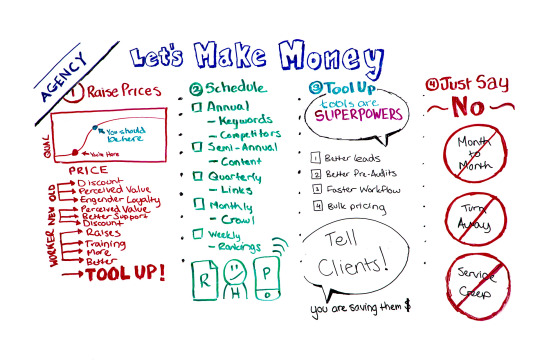
Click on the whiteboard image above to open a high-resolution version in a new tab!
Video Transcription
Howdy, Moz fans. I am Russ Jones, and I can't tell you how excited I am for my first Whiteboard Friday. I am Principal Search Scientist here at Moz. But before coming to Moz, for the 10 years prior to that, I was the Chief Technology Officer of a small SEO agency back in North Carolina. So I have a strong passion for agencies and consultants who are on the ground doing the work, helping websites rank better and helping build businesses.
So what I wanted to do today was spend a little bit of time talking about the lessons that I learned at an agency that admittedly I only learned through trial and error. But before we even go further, I just wanted to thank the folks at Hive Digital who I learned so much from, Jeff and Jake and Malcolm and Ryan, because the team effort over time is what ended up building an agency. Any agency that succeeds knows that that's part of it. So we'll start with that thank-you.
But what I really want to get into is that we spend a lot of time talking about SEO tactics, but not really about how to succeed in an industry that changes rapidly, in which there's almost no certification, and where it can be difficult to explain to customers exactly how they're going to be successful with what you offer. So what I'm going to do is break down four really important rules that I learned over the course of that 10 years. We're going to go through each one of them as quickly as possible, but at the same time, hopefully you'll walk away with some good ideas. Some of these are ones that it might at first feel a little bit awkward, but just follow me.
1. Raise prices
The first rule, number one in Let's Make Money is raise your prices. Now, I remember quite clearly two years in to my job at Hive Digital — it was called Virante then — and we were talking about raising prices. We were just looking at our customers, saying to ourselves, "There's no way they can afford it." But then luckily we had the foresight that there was more to raising prices than just charging your customers more.
How it benefits old customers
The first thing that just hit us automatically was... "Well, with our old customers, we can just discount them. It's not that bad. We're in the same place as we always were." But then it occurred to us, "Wait, wait, wait. If we discount our customers, then we're actually increasing our perceived value." Our existing customers now think, "Hey, they're actually selling something better that's more expensive, but I'm getting a deal," and by offering them that deal because of their loyalty, you engender more loyalty. So it can actually be good for old customers.
How it benefits new customers
Now, for new customers, once again, same sort of situation. You've increased the perceived value. So your customers who come to you think, "Oh, this company is professional. This company is willing to invest. This company is interested in providing the highest quality of services." In reality, because you've raised prices, you can. You can spend more time and money on each customer and actually do a better job. The third part is, "What's the worst that could happen?" If they say no, you offer them the discount. You're back where you started. You're in the same position that you were before.
How it benefits your workers
Now, here's where it really matters — your employees, your workers. If you are offering bottom line prices, you can't offer them raises, you can't offer them training, you can't hire them help, or you can't get better workers. But if you do, if you raise prices, the whole ecosystem that is your agency will do better.
How it improves your resources

Finally, and most importantly, which we'll talk a little bit more later, is that you can finally tool up. You can get the resources and capital that you need to actually succeed. I drew this kind of out.
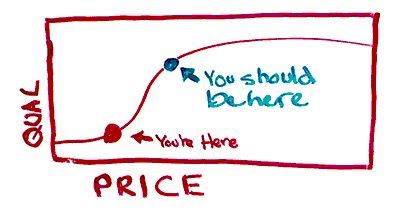
If we have a graph of quality of services that you offer and the price that you sell at, most agencies think that they're offering great quality at a little price, but the reality is you're probably down here. You're probably under-selling your services and, because of that, you can't offer the best that you can.
You should be up here. You should be offering higher quality, your experts who spend time all day studying this, and raising prices allows you to do that.
2. Schedule
Now, raising prices is only part one. The second thing is discipline, and I am really horrible about this. The reality is that I'm the kind of guy who looks for the latest and greatest and just jumps into it, but schedule matters. As hard as it is to admit it, I learned this from the CPC folks because they know that they have to stay on top of it every day of the week.
Well, here's something that we kind of came up with as I was leaving the company, and that was to set all of our customers as much as possible into a schedule.
Annually: we would handle keywords and competitors doing complete analysis.
Semi-annually: Twice a year, we would do content analysis. What should you be writing about? What's changed in your industry? What are different keywords that you might be able to target now given additional resources?
Quarterly: You need to be looking at links. It's just a big enough issue that you've got to look at it every couple of months, a complete link analysis.
Monthly: You should be looking at your crawls. Moz will do that every week for you, but you should give your customers an idea, over the course of a month, what's changed.
Weekly: You should be doing rankings

But there are three things that, when you do all of these types of analysis, you need to keep in mind. Each one of them is a...
Report
Hours for consulting
Phone call
This might seem like a little bit of overkill. But of course, if one of these comes back and nothing changed, you don't need to do the phone call, but each one of these represents additional money in your pocket and importantly better service for your customers.
It might seem hard to believe that when you go to a customer and you tell them, "Look, nothing's changed," that you're actually giving them value, but the truth is that if you go to the dentist and he tells you, you don't have a cavity, that's good news. You shouldn't say to yourself at the end of the day, "Why'd I go to the dentist in the first place?" You should say, "I'm so glad I went to the dentist." By that same positive outlook, you should be selling to your customers over and over and over again, hoping to give them the clarity they need to succeed.
3. Tool up!
So number three, you're going to see this a lot in my videos because I just love SEO tools, but you've got to tool up. Once you've raised prices and you're making more money with your customers, you actually can. Tools are superpowers. Tools allow you to do things that humans just can't do. Like I can't figure out the link graph on my own. I need tools to do it. But tools can do so much more than just auditing existing clients. For example, they can give you...
Better leads:
You can use tools to find opportunities.Take for example the tools within Moz and you want to find other car dealerships in the area that are really good and have an opportunity to rank, but aren't doing as well as they should be in SERPs. You want to do this because you've already serviced successfully a different car dealership. Well, tools like Moz can do that. You don't just have to use Moz to help your clients. You can use them to help yourself.
Better pre-audits:
Nobody walks into a sales call blind. You know who the website is. So you just start with a great pre-audit.
Faster workflows:
Which means you make more money quicker. If you can do your keyword analysis annually in half the time because you have the right tool for it, then you're going to make far more money and be able to serve more customers.
Bulk pricing:
This one is just mind-blowingly simple. It's bulk pricing. Every tool out there, the more you buy from them, the lower the price is. I remember at my old company sitting down at one point and recognizing that every customer that came in the door would need to spend about $1,000 on individual accounts to match what they were getting through us by being able to take advantage of the bulk discounts that we were getting as an agency by buying these seats on behalf of all of our customers.
So tell your clients when you're talking to them on the phone, in the pitch be like, "Look, we use Moz, Majestic, Ahrefs, SEMrush," list off all of the competitors. "We do Screaming Frog." Just name them all and say, "If you wanted to go out and just get the data yourself from these tools, it would cost you more than we're actually charging you." The tools can sell themselves. You are saving them money.
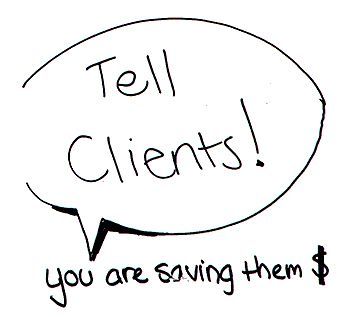
4. Just say NO
Now, the last section, real quickly, are the things you've just got to learn to say no to. One of them has a little nuance to it. There's going to be some bite back in the comments, I'm pretty sure, but I want to be careful with it.
No month-to-month contracts
The first thing to say no to is month-to-month contracts.
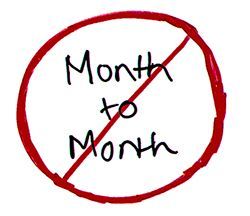
If a customer comes to you and they say, "Look, we want to do SEO, but we want to be able to cancel every 30 days." the reality is this. They're not interested in investing in SEO. They're interested in dabbling in SEO. They're interested in experimenting with SEO. Well, that's not going to succeed. It's only going to take one competitor or two who actually invest in it to beat them out, and when they beat them out, you're going to look bad and they're going to cancel their account with you. So sit down with them and explain to them that it is a long-term strategy and it's just not worth it to your company to bring on customers who aren't interested in investing in SEO. Say it politely, but just turn it away.
Don't turn anything away
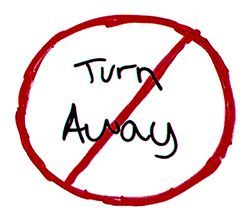
Now, notice that my next thing is don't turn anything away. So here's something careful. Here's the nuance. It's really important to learn to fire clients who are bad for your business, where you're losing money on them or they're just impolite, but that doesn't mean you have to turn them away. You just need to turn them in the right direction. That right direction might be tools themselves. You can say, "Look, you don't really need our consulting hours. You should go use these tools." Or you can turn them to other fledgling businesses, friends you have in the industry who might be struggling at this time.
I'll tell you a quick example. We don't have much time, but many, many years ago, we had a client that came to us. At our old company, we had a couple of rules about who we would work with. We chose not to work in the adult industry. But at the time, I had a friend in the industry. He lived outside of the United States, and he had fallen on hard times. He literally had his business taken away from him via a series of just really unscrupulous events. I picked up the phone and gave him a call. I didn't turn away the customer. I turned them over to this individual.
That very next year, he had ended up landing a new job at the top of one of the largest gambling organizations in the world. Well, frankly, they weren't on our list of people we couldn't work with. We landed the largest contract in the history of our company at that time, and it set our company straight for an entire year. It was just because instead of turning away the client, we turned them to a different direction. So you've got to say no to turning away everybody. They are opportunities. They might not be your opportunity, but they're someone's.
No service creep
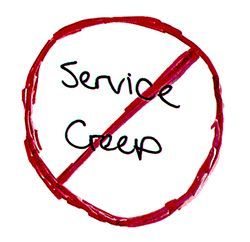
The last one is service creep. Oh, man, this one is hard. A customer comes up to you and they list off three things that you offer that they want, and then they say, "Oh, yeah, we need social media management." Somebody else comes up to you, three things you want to offer, and they say, "Oh yeah, we need you to write content," and that's not something you do. You've just got to not do that. You've got to learn to shave off services that you can't offer. Instead, turn them over to people who can do them and do them very well.
What you're going to end up doing in your conversation, your sales pitch is, "Look, I'm going to be honest with you. We are great at some things, but this isn't our cup of tea. We know someone who's really great at it." That honesty, that candidness is just going to give them such a better relationship with you, and it's going to build a stronger relationship with those other specialty companies who are going to send business your way. So it's really important to learn to say no to say no service creep.
Well, anyway, there's a lot that we went over there. I hope it wasn't too much too fast, but hopefully we can talk more about it in the comments. I look forward to seeing you there. Thanks.
Video transcription by Speechpad.com
Ready for more?
You'll uncover even more SEO goodness in the MozCon 2020 video bundle. At this year's special low price of $129, this is invaluable content you can access again and again throughout the year to inspire and ignite your SEO strategy:
21 full-length videos from some of the brightest minds in digital marketing
Instant downloads and streaming to your computer, tablet, or mobile device
Downloadable slide decks for presentations
Get my MozCon 2020 video bundle
Sign up for The Moz Top 10, a semimonthly mailer updating you on the top ten hottest pieces of SEO news, tips, and rad links uncovered by the Moz team. Think of it as your exclusive digest of stuff you don't have time to hunt down but want to read!
#túi_giấy_epacking_việt_nam #túi_giấy_epacking #in_túi_giấy_giá_rẻ #in_túi_giấy #epackingvietnam #tuigiayepacking
0 notes
Text
Let's Make Money: 4 Tactics for Agencies Looking to Succeed – Best of Whiteboard Friday
Posted by rjonesx.
We spend a lot of time discussing SEO tactics, but in a constantly changing industry and especially in times of uncertainty, the strategies agencies should employ in order to see success deserve more attention. In this popular (and still relevant) Whiteboard Friday, Russ Jones discusses four essential success tactics that'll ultimately increase your bottom line. Russ also delved into the topic of profitability in his MozCon Virtual presentation this year. To watch his and our other amazing speaker presentations, you can purchase access to the 2020 video bundle here.

Click on the whiteboard image above to open a high-resolution version in a new tab!
Video Transcription
Howdy, Moz fans. I am Russ Jones, and I can't tell you how excited I am for my first Whiteboard Friday. I am Principal Search Scientist here at Moz. But before coming to Moz, for the 10 years prior to that, I was the Chief Technology Officer of a small SEO agency back in North Carolina. So I have a strong passion for agencies and consultants who are on the ground doing the work, helping websites rank better and helping build businesses.
So what I wanted to do today was spend a little bit of time talking about the lessons that I learned at an agency that admittedly I only learned through trial and error. But before we even go further, I just wanted to thank the folks at Hive Digital who I learned so much from, Jeff and Jake and Malcolm and Ryan, because the team effort over time is what ended up building an agency. Any agency that succeeds knows that that's part of it. So we'll start with that thank-you.
But what I really want to get into is that we spend a lot of time talking about SEO tactics, but not really about how to succeed in an industry that changes rapidly, in which there's almost no certification, and where it can be difficult to explain to customers exactly how they're going to be successful with what you offer. So what I'm going to do is break down four really important rules that I learned over the course of that 10 years. We're going to go through each one of them as quickly as possible, but at the same time, hopefully you'll walk away with some good ideas. Some of these are ones that it might at first feel a little bit awkward, but just follow me.
1. Raise prices
The first rule, number one in Let's Make Money is raise your prices. Now, I remember quite clearly two years in to my job at Hive Digital — it was called Virante then — and we were talking about raising prices. We were just looking at our customers, saying to ourselves, "There's no way they can afford it." But then luckily we had the foresight that there was more to raising prices than just charging your customers more.
How it benefits old customers
The first thing that just hit us automatically was... "Well, with our old customers, we can just discount them. It's not that bad. We're in the same place as we always were." But then it occurred to us, "Wait, wait, wait. If we discount our customers, then we're actually increasing our perceived value." Our existing customers now think, "Hey, they're actually selling something better that's more expensive, but I'm getting a deal," and by offering them that deal because of their loyalty, you engender more loyalty. So it can actually be good for old customers.
How it benefits new customers
Now, for new customers, once again, same sort of situation. You've increased the perceived value. So your customers who come to you think, "Oh, this company is professional. This company is willing to invest. This company is interested in providing the highest quality of services." In reality, because you've raised prices, you can. You can spend more time and money on each customer and actually do a better job. The third part is, "What's the worst that could happen?" If they say no, you offer them the discount. You're back where you started. You're in the same position that you were before.
How it benefits your workers
Now, here's where it really matters — your employees, your workers. If you are offering bottom line prices, you can't offer them raises, you can't offer them training, you can't hire them help, or you can't get better workers. But if you do, if you raise prices, the whole ecosystem that is your agency will do better.
How it improves your resources

Finally, and most importantly, which we'll talk a little bit more later, is that you can finally tool up. You can get the resources and capital that you need to actually succeed. I drew this kind of out.
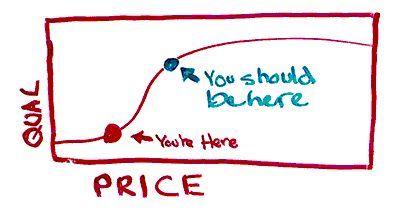
If we have a graph of quality of services that you offer and the price that you sell at, most agencies think that they're offering great quality at a little price, but the reality is you're probably down here. You're probably under-selling your services and, because of that, you can't offer the best that you can.
You should be up here. You should be offering higher quality, your experts who spend time all day studying this, and raising prices allows you to do that.
2. Schedule
Now, raising prices is only part one. The second thing is discipline, and I am really horrible about this. The reality is that I'm the kind of guy who looks for the latest and greatest and just jumps into it, but schedule matters. As hard as it is to admit it, I learned this from the CPC folks because they know that they have to stay on top of it every day of the week.
Well, here's something that we kind of came up with as I was leaving the company, and that was to set all of our customers as much as possible into a schedule.
Annually: we would handle keywords and competitors doing complete analysis.
Semi-annually: Twice a year, we would do content analysis. What should you be writing about? What's changed in your industry? What are different keywords that you might be able to target now given additional resources?
Quarterly: You need to be looking at links. It's just a big enough issue that you've got to look at it every couple of months, a complete link analysis.
Monthly: You should be looking at your crawls. Moz will do that every week for you, but you should give your customers an idea, over the course of a month, what's changed.
Weekly: You should be doing rankings

But there are three things that, when you do all of these types of analysis, you need to keep in mind. Each one of them is a...
Report
Hours for consulting
Phone call
This might seem like a little bit of overkill. But of course, if one of these comes back and nothing changed, you don't need to do the phone call, but each one of these represents additional money in your pocket and importantly better service for your customers.
It might seem hard to believe that when you go to a customer and you tell them, "Look, nothing's changed," that you're actually giving them value, but the truth is that if you go to the dentist and he tells you, you don't have a cavity, that's good news. You shouldn't say to yourself at the end of the day, "Why'd I go to the dentist in the first place?" You should say, "I'm so glad I went to the dentist." By that same positive outlook, you should be selling to your customers over and over and over again, hoping to give them the clarity they need to succeed.
3. Tool up!
So number three, you're going to see this a lot in my videos because I just love SEO tools, but you've got to tool up. Once you've raised prices and you're making more money with your customers, you actually can. Tools are superpowers. Tools allow you to do things that humans just can't do. Like I can't figure out the link graph on my own. I need tools to do it. But tools can do so much more than just auditing existing clients. For example, they can give you...
Better leads:
You can use tools to find opportunities.Take for example the tools within Moz and you want to find other car dealerships in the area that are really good and have an opportunity to rank, but aren't doing as well as they should be in SERPs. You want to do this because you've already serviced successfully a different car dealership. Well, tools like Moz can do that. You don't just have to use Moz to help your clients. You can use them to help yourself.
Better pre-audits:
Nobody walks into a sales call blind. You know who the website is. So you just start with a great pre-audit.
Faster workflows:
Which means you make more money quicker. If you can do your keyword analysis annually in half the time because you have the right tool for it, then you're going to make far more money and be able to serve more customers.
Bulk pricing:
This one is just mind-blowingly simple. It's bulk pricing. Every tool out there, the more you buy from them, the lower the price is. I remember at my old company sitting down at one point and recognizing that every customer that came in the door would need to spend about $1,000 on individual accounts to match what they were getting through us by being able to take advantage of the bulk discounts that we were getting as an agency by buying these seats on behalf of all of our customers.
So tell your clients when you're talking to them on the phone, in the pitch be like, "Look, we use Moz, Majestic, Ahrefs, SEMrush," list off all of the competitors. "We do Screaming Frog." Just name them all and say, "If you wanted to go out and just get the data yourself from these tools, it would cost you more than we're actually charging you." The tools can sell themselves. You are saving them money.
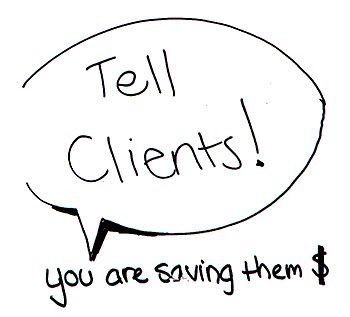
4. Just say NO
Now, the last section, real quickly, are the things you've just got to learn to say no to. One of them has a little nuance to it. There's going to be some bite back in the comments, I'm pretty sure, but I want to be careful with it.
No month-to-month contracts
The first thing to say no to is month-to-month contracts.

If a customer comes to you and they say, "Look, we want to do SEO, but we want to be able to cancel every 30 days." the reality is this. They're not interested in investing in SEO. They're interested in dabbling in SEO. They're interested in experimenting with SEO. Well, that's not going to succeed. It's only going to take one competitor or two who actually invest in it to beat them out, and when they beat them out, you're going to look bad and they're going to cancel their account with you. So sit down with them and explain to them that it is a long-term strategy and it's just not worth it to your company to bring on customers who aren't interested in investing in SEO. Say it politely, but just turn it away.
Don't turn anything away
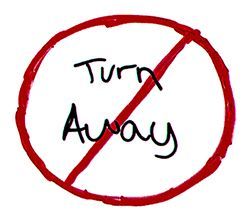
Now, notice that my next thing is don't turn anything away. So here's something careful. Here's the nuance. It's really important to learn to fire clients who are bad for your business, where you're losing money on them or they're just impolite, but that doesn't mean you have to turn them away. You just need to turn them in the right direction. That right direction might be tools themselves. You can say, "Look, you don't really need our consulting hours. You should go use these tools." Or you can turn them to other fledgling businesses, friends you have in the industry who might be struggling at this time.
I'll tell you a quick example. We don't have much time, but many, many years ago, we had a client that came to us. At our old company, we had a couple of rules about who we would work with. We chose not to work in the adult industry. But at the time, I had a friend in the industry. He lived outside of the United States, and he had fallen on hard times. He literally had his business taken away from him via a series of just really unscrupulous events. I picked up the phone and gave him a call. I didn't turn away the customer. I turned them over to this individual.
That very next year, he had ended up landing a new job at the top of one of the largest gambling organizations in the world. Well, frankly, they weren't on our list of people we couldn't work with. We landed the largest contract in the history of our company at that time, and it set our company straight for an entire year. It was just because instead of turning away the client, we turned them to a different direction. So you've got to say no to turning away everybody. They are opportunities. They might not be your opportunity, but they're someone's.
No service creep

The last one is service creep. Oh, man, this one is hard. A customer comes up to you and they list off three things that you offer that they want, and then they say, "Oh, yeah, we need social media management." Somebody else comes up to you, three things you want to offer, and they say, "Oh yeah, we need you to write content," and that's not something you do. You've just got to not do that. You've got to learn to shave off services that you can't offer. Instead, turn them over to people who can do them and do them very well.
What you're going to end up doing in your conversation, your sales pitch is, "Look, I'm going to be honest with you. We are great at some things, but this isn't our cup of tea. We know someone who's really great at it." That honesty, that candidness is just going to give them such a better relationship with you, and it's going to build a stronger relationship with those other specialty companies who are going to send business your way. So it's really important to learn to say no to say no service creep.
Well, anyway, there's a lot that we went over there. I hope it wasn't too much too fast, but hopefully we can talk more about it in the comments. I look forward to seeing you there. Thanks.
Video transcription by Speechpad.com
Ready for more?
You'll uncover even more SEO goodness in the MozCon 2020 video bundle. At this year's special low price of $129, this is invaluable content you can access again and again throughout the year to inspire and ignite your SEO strategy:
21 full-length videos from some of the brightest minds in digital marketing
Instant downloads and streaming to your computer, tablet, or mobile device
Downloadable slide decks for presentations
Get my MozCon 2020 video bundle
Sign up for The Moz Top 10, a semimonthly mailer updating you on the top ten hottest pieces of SEO news, tips, and rad links uncovered by the Moz team. Think of it as your exclusive digest of stuff you don't have time to hunt down but want to read!
0 notes
Text
Let's Make Money: 4 Tactics for Agencies Looking to Succeed – Best of Whiteboard Friday
Posted by rjonesx.
We spend a lot of time discussing SEO tactics, but in a constantly changing industry and especially in times of uncertainty, the strategies agencies should employ in order to see success deserve more attention. In this popular (and still relevant) Whiteboard Friday, Russ Jones discusses four essential success tactics that'll ultimately increase your bottom line. Russ also delved into the topic of profitability in his MozCon Virtual presentation this year. To watch his and our other amazing speaker presentations, you can purchase access to the 2020 video bundle here.
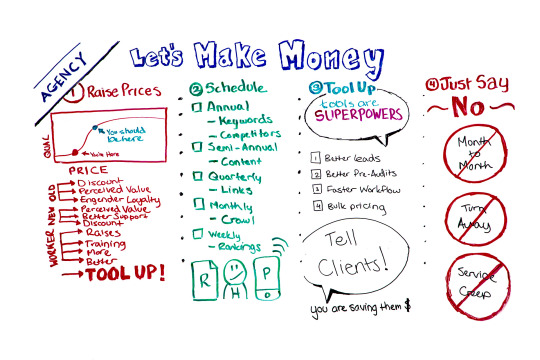
Click on the whiteboard image above to open a high-resolution version in a new tab!
Video Transcription
Howdy, Moz fans. I am Russ Jones, and I can't tell you how excited I am for my first Whiteboard Friday. I am Principal Search Scientist here at Moz. But before coming to Moz, for the 10 years prior to that, I was the Chief Technology Officer of a small SEO agency back in North Carolina. So I have a strong passion for agencies and consultants who are on the ground doing the work, helping websites rank better and helping build businesses.
So what I wanted to do today was spend a little bit of time talking about the lessons that I learned at an agency that admittedly I only learned through trial and error. But before we even go further, I just wanted to thank the folks at Hive Digital who I learned so much from, Jeff and Jake and Malcolm and Ryan, because the team effort over time is what ended up building an agency. Any agency that succeeds knows that that's part of it. So we'll start with that thank-you.
But what I really want to get into is that we spend a lot of time talking about SEO tactics, but not really about how to succeed in an industry that changes rapidly, in which there's almost no certification, and where it can be difficult to explain to customers exactly how they're going to be successful with what you offer. So what I'm going to do is break down four really important rules that I learned over the course of that 10 years. We're going to go through each one of them as quickly as possible, but at the same time, hopefully you'll walk away with some good ideas. Some of these are ones that it might at first feel a little bit awkward, but just follow me.
1. Raise prices
The first rule, number one in Let's Make Money is raise your prices. Now, I remember quite clearly two years in to my job at Hive Digital — it was called Virante then — and we were talking about raising prices. We were just looking at our customers, saying to ourselves, "There's no way they can afford it." But then luckily we had the foresight that there was more to raising prices than just charging your customers more.
How it benefits old customers
The first thing that just hit us automatically was... "Well, with our old customers, we can just discount them. It's not that bad. We're in the same place as we always were." But then it occurred to us, "Wait, wait, wait. If we discount our customers, then we're actually increasing our perceived value." Our existing customers now think, "Hey, they're actually selling something better that's more expensive, but I'm getting a deal," and by offering them that deal because of their loyalty, you engender more loyalty. So it can actually be good for old customers.
How it benefits new customers
Now, for new customers, once again, same sort of situation. You've increased the perceived value. So your customers who come to you think, "Oh, this company is professional. This company is willing to invest. This company is interested in providing the highest quality of services." In reality, because you've raised prices, you can. You can spend more time and money on each customer and actually do a better job. The third part is, "What's the worst that could happen?" If they say no, you offer them the discount. You're back where you started. You're in the same position that you were before.
How it benefits your workers
Now, here's where it really matters — your employees, your workers. If you are offering bottom line prices, you can't offer them raises, you can't offer them training, you can't hire them help, or you can't get better workers. But if you do, if you raise prices, the whole ecosystem that is your agency will do better.
How it improves your resources

Finally, and most importantly, which we'll talk a little bit more later, is that you can finally tool up. You can get the resources and capital that you need to actually succeed. I drew this kind of out.
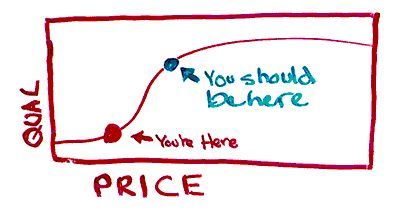
If we have a graph of quality of services that you offer and the price that you sell at, most agencies think that they're offering great quality at a little price, but the reality is you're probably down here. You're probably under-selling your services and, because of that, you can't offer the best that you can.
You should be up here. You should be offering higher quality, your experts who spend time all day studying this, and raising prices allows you to do that.
2. Schedule
Now, raising prices is only part one. The second thing is discipline, and I am really horrible about this. The reality is that I'm the kind of guy who looks for the latest and greatest and just jumps into it, but schedule matters. As hard as it is to admit it, I learned this from the CPC folks because they know that they have to stay on top of it every day of the week.
Well, here's something that we kind of came up with as I was leaving the company, and that was to set all of our customers as much as possible into a schedule.
Annually: we would handle keywords and competitors doing complete analysis.
Semi-annually: Twice a year, we would do content analysis. What should you be writing about? What's changed in your industry? What are different keywords that you might be able to target now given additional resources?
Quarterly: You need to be looking at links. It's just a big enough issue that you've got to look at it every couple of months, a complete link analysis.
Monthly: You should be looking at your crawls. Moz will do that every week for you, but you should give your customers an idea, over the course of a month, what's changed.
Weekly: You should be doing rankings

But there are three things that, when you do all of these types of analysis, you need to keep in mind. Each one of them is a...
Report
Hours for consulting
Phone call
This might seem like a little bit of overkill. But of course, if one of these comes back and nothing changed, you don't need to do the phone call, but each one of these represents additional money in your pocket and importantly better service for your customers.
It might seem hard to believe that when you go to a customer and you tell them, "Look, nothing's changed," that you're actually giving them value, but the truth is that if you go to the dentist and he tells you, you don't have a cavity, that's good news. You shouldn't say to yourself at the end of the day, "Why'd I go to the dentist in the first place?" You should say, "I'm so glad I went to the dentist." By that same positive outlook, you should be selling to your customers over and over and over again, hoping to give them the clarity they need to succeed.
3. Tool up!
So number three, you're going to see this a lot in my videos because I just love SEO tools, but you've got to tool up. Once you've raised prices and you're making more money with your customers, you actually can. Tools are superpowers. Tools allow you to do things that humans just can't do. Like I can't figure out the link graph on my own. I need tools to do it. But tools can do so much more than just auditing existing clients. For example, they can give you...
Better leads:
You can use tools to find opportunities.Take for example the tools within Moz and you want to find other car dealerships in the area that are really good and have an opportunity to rank, but aren't doing as well as they should be in SERPs. You want to do this because you've already serviced successfully a different car dealership. Well, tools like Moz can do that. You don't just have to use Moz to help your clients. You can use them to help yourself.
Better pre-audits:
Nobody walks into a sales call blind. You know who the website is. So you just start with a great pre-audit.
Faster workflows:
Which means you make more money quicker. If you can do your keyword analysis annually in half the time because you have the right tool for it, then you're going to make far more money and be able to serve more customers.
Bulk pricing:
This one is just mind-blowingly simple. It's bulk pricing. Every tool out there, the more you buy from them, the lower the price is. I remember at my old company sitting down at one point and recognizing that every customer that came in the door would need to spend about $1,000 on individual accounts to match what they were getting through us by being able to take advantage of the bulk discounts that we were getting as an agency by buying these seats on behalf of all of our customers.
So tell your clients when you're talking to them on the phone, in the pitch be like, "Look, we use Moz, Majestic, Ahrefs, SEMrush," list off all of the competitors. "We do Screaming Frog." Just name them all and say, "If you wanted to go out and just get the data yourself from these tools, it would cost you more than we're actually charging you." The tools can sell themselves. You are saving them money.
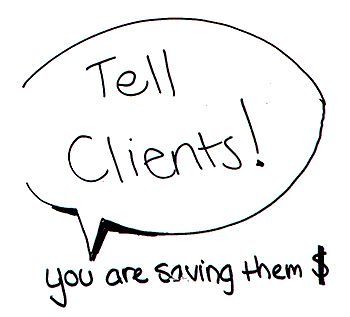
4. Just say NO
Now, the last section, real quickly, are the things you've just got to learn to say no to. One of them has a little nuance to it. There's going to be some bite back in the comments, I'm pretty sure, but I want to be careful with it.
No month-to-month contracts
The first thing to say no to is month-to-month contracts.

If a customer comes to you and they say, "Look, we want to do SEO, but we want to be able to cancel every 30 days." the reality is this. They're not interested in investing in SEO. They're interested in dabbling in SEO. They're interested in experimenting with SEO. Well, that's not going to succeed. It's only going to take one competitor or two who actually invest in it to beat them out, and when they beat them out, you're going to look bad and they're going to cancel their account with you. So sit down with them and explain to them that it is a long-term strategy and it's just not worth it to your company to bring on customers who aren't interested in investing in SEO. Say it politely, but just turn it away.
Don't turn anything away
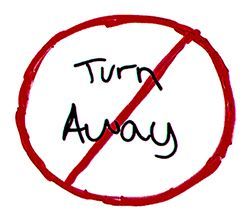
Now, notice that my next thing is don't turn anything away. So here's something careful. Here's the nuance. It's really important to learn to fire clients who are bad for your business, where you're losing money on them or they're just impolite, but that doesn't mean you have to turn them away. You just need to turn them in the right direction. That right direction might be tools themselves. You can say, "Look, you don't really need our consulting hours. You should go use these tools." Or you can turn them to other fledgling businesses, friends you have in the industry who might be struggling at this time.
I'll tell you a quick example. We don't have much time, but many, many years ago, we had a client that came to us. At our old company, we had a couple of rules about who we would work with. We chose not to work in the adult industry. But at the time, I had a friend in the industry. He lived outside of the United States, and he had fallen on hard times. He literally had his business taken away from him via a series of just really unscrupulous events. I picked up the phone and gave him a call. I didn't turn away the customer. I turned them over to this individual.
That very next year, he had ended up landing a new job at the top of one of the largest gambling organizations in the world. Well, frankly, they weren't on our list of people we couldn't work with. We landed the largest contract in the history of our company at that time, and it set our company straight for an entire year. It was just because instead of turning away the client, we turned them to a different direction. So you've got to say no to turning away everybody. They are opportunities. They might not be your opportunity, but they're someone's.
No service creep
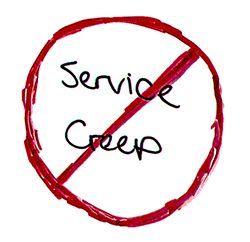
The last one is service creep. Oh, man, this one is hard. A customer comes up to you and they list off three things that you offer that they want, and then they say, "Oh, yeah, we need social media management." Somebody else comes up to you, three things you want to offer, and they say, "Oh yeah, we need you to write content," and that's not something you do. You've just got to not do that. You've got to learn to shave off services that you can't offer. Instead, turn them over to people who can do them and do them very well.
What you're going to end up doing in your conversation, your sales pitch is, "Look, I'm going to be honest with you. We are great at some things, but this isn't our cup of tea. We know someone who's really great at it." That honesty, that candidness is just going to give them such a better relationship with you, and it's going to build a stronger relationship with those other specialty companies who are going to send business your way. So it's really important to learn to say no to say no service creep.
Well, anyway, there's a lot that we went over there. I hope it wasn't too much too fast, but hopefully we can talk more about it in the comments. I look forward to seeing you there. Thanks.
Video transcription by Speechpad.com
Ready for more?
You'll uncover even more SEO goodness in the MozCon 2020 video bundle. At this year's special low price of $129, this is invaluable content you can access again and again throughout the year to inspire and ignite your SEO strategy:
21 full-length videos from some of the brightest minds in digital marketing
Instant downloads and streaming to your computer, tablet, or mobile device
Downloadable slide decks for presentations
Get my MozCon 2020 video bundle
Sign up for The Moz Top 10, a semimonthly mailer updating you on the top ten hottest pieces of SEO news, tips, and rad links uncovered by the Moz team. Think of it as your exclusive digest of stuff you don't have time to hunt down but want to read!
0 notes